
About UsThe Numismatic Bibliomania Society is a non-profit association devoted to the study and enjoyment of numismatic literature. For more information please see our web site at coinbooks.org SubscriptionsThose wishing to become new E-Sylum subscribers (or wishing to Unsubscribe) can go to the following web page link MembershipThere is a membership application available on the web site Membership Application To join, print the application and return it with your check to the address printed on the application. Print/Digital membership is $40 to addresses in the U.S., and $60 elsewhere. A digital-only membership is available for $25. For those without web access, write to: Terry White, Treasurer
AsylumFor Asylum mailing address changes and other membership questions, contact Terry at this email address: terrywhite5475@yahoo.com SubmissionsTo submit items for publication in The E-Sylum, write to the Editor at this address: whomren@gmail.com BUY THE BOOK BEFORE THE COINSale Calendar |
- WAYNE'S WORDS: THE E-SYLUM MARCH 10, 2019
- NEW BOOK: THE HALF CENT, 1793-1857
- NEW BOOK: TREASURY NOTES OF THE WAR OF 1812
- MUSINGS ON THE GUIDE BOOK OF LINCOLN CENTS
- PHOTO OF ENGRAVER WILLIAM BARBER FOUND
- BURNS LIBRARY AT THE ANA NATIONAL MONEY SHOW
- NEWMAN PORTAL ADDS SPURRIER VIDEO: "THE CENT"
- NUMISMATIC HOLMES FANS TO MEET IN PITTSBURGH
- NOTES FROM E-SYLUM READERS: MARCH 10, 2019
- THE WEDDING MEDAL CHRONOGRAM
- GUTTAG NEW YORK STORECARD CENSUS
- ENCASED COIN STATE GRAND LODGE RICHMOND, VA
- GEOGRAPHY, METALLURGY BOOKS AVAILABLE
- VOCABULARY TERMS: CAST, CASTING
- DR. ALBERT LEROY FISHER (1845-1918)
- HARVEY STACK'S NUMISMATIC FAMILY, PART 39
- HONG KONG COIN SHOW EDUCATIONAL EVENTS
- HERITAGE TO OFFER COOK CANADIAN COIN COLLECTION
- NUMISMAGRAM MEDAL SELECTIONS: MARCH 2019
- LANGE OFFERS COIN FOLDER LIST #104
- WAYNE'S NUMISMATIC DIARY: MARCH 10, 2019
- INDIAN ARCHAEOLOGISTS WARN ABOUT FAKE COINS
- ALBANY CHURCH PENNY WITHOUT D VARIETY
- BRITISH INDIA HALF RUPEE BUST VARIETY
- CANADIAN FIVE CENT TERMS: FIPPENCE, FIPPENNY
- THE GREEK HALF-DRACHMAI BANKNOTE
- CURRENCY IDENTIFIERS
- LIBERIAN BANKNOTE SCHEME REVEALED
- U.S. MINT PROOF BULLION COINS AS INVESTMENTS
- LOOSE CHANGE: MARCH 10, 2019
- FEATURED WEB SITE: NUMISMAG
Click here to access the complete archive
Click here to unsubscribe (scroll down)
To comment or submit articles, reply to whomren@gmail.com
Content presented in The E-Sylum is not necessarily researched or independently fact-checked, and views expressed do not necessarily represent those of the Numismatic Bibliomania Society.
WAYNE'S WORDS: THE E-SYLUM MARCH 10, 2019
 New subscribers this week include: Matt Mayers, courtesy of Dave Perkins; Len Trakalo of Canada, courtesy of John Regitko; and Mark Bun. Welcome aboard! We now have 5,840 subscribers.
New subscribers this week include: Matt Mayers, courtesy of Dave Perkins; Len Trakalo of Canada, courtesy of John Regitko; and Mark Bun. Welcome aboard! We now have 5,840 subscribers.
Thank you for reading The E-Sylum. If you enjoy it, please send me the email addresses of friends you think may enjoy it as well and I'll send them a subscription (but let me know if they are located in the European Union). Contact me at whomren@gmail.com anytime regarding your subscription, or questions, comments or suggestions about our content.
For the second week in a row I've been unable to catch up with the inflow of submissions. My apologies to those who sent material that didn't make it into this issue. I'll see what I can do next week.
This week we open with two new books, background on the Guide Book of Lincoln Cents, a long-sought photo of William Barber, the Burns Library, and an update from the Newman Numismatic Portal.
Other topics this week include chronograms, Guttag Brothers storecards, collector A. L. Fisher, the Hong Kong Coin Show, the Albany Church Penny, the greek Half-Drachmai banknote, currency identifiers, and a Liberian banknote fraud scheme.
To learn more about the U.S. Half Cent, Treasury Notes of the War of 1812, a Golden Age of Numismatic Editorship, the Panama-Pacific Exposition Award medal, a Jefferson Head cent electrotype, the Ghost Oak Tree shilling, the exergual line, the blobular mintmark, and the best 1804 cent that $15 can buy, read on. Have a great week, everyone!
Wayne Homren
Editor, The E-Sylum
NEW BOOK: THE HALF CENT, 1793-1857
Bill Eckberg is accepting orders for his new book on U.S. Half Cents. -Editor
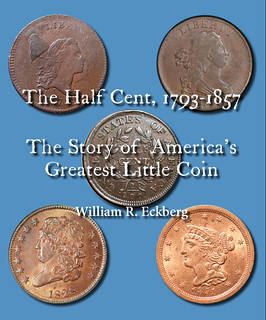 I am announcing the upcoming release of my new book, The Half Cent 1793-1857; America's Greatest Little Coin in the January Penny-Wise. The hardcover book is currently being printed and will be released on May 3 at the Early American Coppers (EAC) convention in Dayton, OH. The edition is 500.
I am announcing the upcoming release of my new book, The Half Cent 1793-1857; America's Greatest Little Coin in the January Penny-Wise. The hardcover book is currently being printed and will be released on May 3 at the Early American Coppers (EAC) convention in Dayton, OH. The edition is 500.
Persons wishing to get a copy at the convention are advised to preorder, as I don't intend to bring more copies to the convention than have been ordered. The cover price is $125, but members of EAC, C4 and NBS can order it for $95. Pre-orders for pickup at the convention are $75 and, of course, no shipping charge for copies picked up at the convention.
A very few leather bound copies are still available at $400. They will probably not be available until after the convention, as hand leather binding is a slow process.
Please see http://halfcentbook.com for more information, sample pages and ordering instructions.
For more information, see:
http://halfcentbook.com/

NEW BOOK: TREASURY NOTES OF THE WAR OF 1812
Don Kagin has authored a new book on the rare and important Treasury Notes of the War of 1812. Here's the announcement. -Editor
 TREASURY NOTES OF THE WAR OF 1812
TREASURY NOTES OF THE WAR OF 1812
By Donald H. Kagin, Ph.D.
This 52-page hardbound story and catalog listing of the Treasury Notes of the War of 1812 is the first reference work covering the complete accounting of the first circulating currency of the United States. Related in succinct yet comprehensive narrative, this work tells the story of our fledgling nation's struggles to finance the War of 1812 against Great Britain, often called, "America's Second War for Independence."
Without garnering adequate funding from import duties and loans, paper currency proponents eventually prevailed over political opposition, resulting in Congress authorizing the Treasury Department to print interest bearing Treasury Notes and eventually non-interest-bearing notes which circulated as the new nation's first currency.
This often overlooked but immensely important series of United States paper currency is presented with a dozen tables, over a hundred citations and references and a complete listing with images of all known issues, types and varieties for the first time.
Copies of the limited edition of 250 hardbound books may be purchased by contacting info@Kagins.com or 888-852-4467.
The retail price is $39.95 plus shipping. Contact Kagin's for details.
At my request Kagin's kindly provided these images of a few selected notes described in the book. Thank you! -Editor
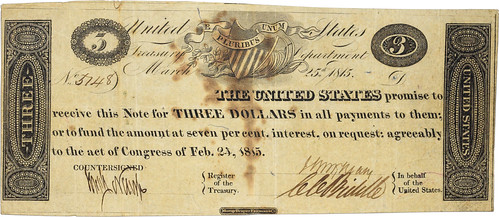

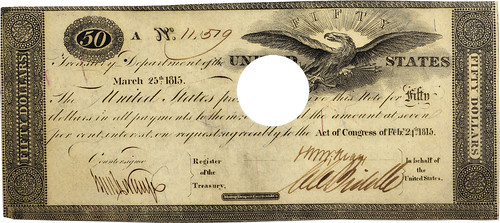
The book grew out of the cataloging of the Joel R. Anderson Collection of the Treasury Notes of the War of 1812. The sale will be held by Kagin's March 29, 2019 at the American Numismatic Association National Money Show in Pittsburgh. For more information, see the March 5, 2019 Coin World article by Art Friedberg. Here's an interesting excerpt. -Editor
The sale's featured item is the first public offering of a unique $10 note that is now designated Friedberg TN-14b, but will be TN-14c in the next Paper Money of the United States. It was just published in the new Treasury Notes of the War of 1812 by Donald H. Kagin. Kagin says it is considered to be the first circulating bank note of the U.S. government.
This note was depicted in a line drawing in the 1978 reprint of the 1885 book United States Notes by John Jay Knox. Its whereabouts was unknown for almost four decades, until it resurfaced at a dealer's table at the Florida United Numismatists 2015 show. The firm estimates it at $150,000 to $250,000.
To read the complete article, see:
Anderson's War of 1812 Treasury notes lead Kagin's auction (https://www.coinworld.com/news/paper-money/2019/03/war-of-1812-treasury-notes-anderson-sale-by-kagins.all.html)

MUSINGS ON THE GUIDE BOOK OF LINCOLN CENTS
Dennis Tucker of Whitman Publications submitted these musings on the publication of the 3rd edition of A Guide Book of Lincoln Cents . Thanks. -Editor
by Dennis Tucker, Publisher, Whitman Publishing
 In the United States today the Lincoln cent is the most popular "classic" collector coin. Uniquely, it holds that position while also being one of the most popular modern coins.
In the United States today the Lincoln cent is the most popular "classic" collector coin. Uniquely, it holds that position while also being one of the most popular modern coins.
To call the Lincoln cent a classic American coin is to group it with Buffalo nickels, Mercury dimes, Standing Liberty quarters, Liberty Walking half dollars, and Saint-Gaudens double eagles—all well-loved series that were born in the "Renaissance" era of U.S. coinage at the beginning of the 1900s.
Many active hobbyists collect Lincoln cents. So do people who don't consider themselves numismatists, but simply enjoy saving interesting coins. Among other currently circulating coinage only Washington quarters—specifically, the 1999 to 2008 State quarters—have matched their broad popularity.
Since I started working at Whitman Publishing in 2004, Lincoln cents have never been far from the front burner, measured by reader interest, ongoing numismatic research, and sales of folders, albums, and other hobby supplies.
Serious discussion of publishing a Guide Book of Lincoln Cents got under way in December 2006. Which grades would we include in the price charts, knowing that there are Brown, Red-Brown, and Red color designations in the higher Mint State conditions? "I need to figure out how to make the price grid not look like a bingo board!" author Q. David Bowers told me.
By the spring of 2007 we were gathering images and photographing coins as needed, with staff photographer Tom Mulvaney focusing on early dates and major die varieties. (Tom, at the time, was also photographing hundreds of pieces for the Guide Book of Canadian Coins and Tokens, and the Guide Book of United States Tokens and Medals.)
That June I invited Lincoln cent specialist Charles Daughtrey to write the book's foreword.
Dave Bowers was simultaneously working on the first edition of the Guide Book of United States Commemorative Coins. He's always enjoyed working on multiple projects "in parallel," as he calls it, likening his process to a chess master who used to visit his son's elementary-school chess club in Shrewsbury: "They had 35 chess boards, and he played 35 opponents all at the same time!"
I touched base with the United States Mint that May, looking for photographs and any new information on Lincoln cents. David W. Lange granted permission to quote from his Complete Guide to Lincoln Cents, and Cherrypickers' Guide coauthor J.T. Stanton offered to go through his notes and photographs of die varieties. Ken Potter, Bill Fivaz, Kenneth Bressett, Sam Lukes, Stewart Blay, Roger W. Burdette, Randy Campbell, John Dannreuther, Beth Deisher, Lee Gast, Paul Gilkes, Bob Shippee, David Sundman, Frank Van Valen, and other numismatists shared photographs, discussed die varieties, and advised on questions and ideas. This kind of collaboration is fundamental to Dave Bowers's success as a researcher and author.
In the midst of all this activity, in June 2007, Fred L. Reed pitched his manuscript for a new book on Abraham Lincoln in numismatics. It would develop into two volumes—Abraham Lincoln: The Image of His Greatness, and, later, a sequel, Abraham Lincoln: Beyond the American Icon. Interest was building toward the 2009 bicentennial of Lincoln's birth.
Dave's manuscript was done and submitted for final editing before the end of July 2007. Layout and proofing came next, and we sent the book to press in September. (By that time the Sage of Wolfeboro, never one to rest for long, was well into his work on the Whitman Encyclopedia of Colonial and Early American Coins.) In early November I alerted the numismatic press that the book was on its way, and in December 2007 it was in readers' hands.
Collectors bought tens of thousands of copies of the first edition. When it debuted I wrote: "One of the goals of Whitman's Bowers Series is to offer the human touch that connects coins to people and to history. A Guide Book of Lincoln Cents lives up to that goal. I believe it will greatly please the numismatists who already collect these coins, and encourage others to start a new collection."
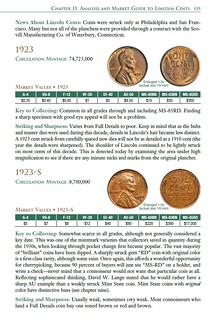

In an informal poll of 130 hobbyists in the summer of 2018, I found that 33 percent consider themselves active or very active collectors of Lincoln cents (constantly upgrading their sets, collecting die varieties by Fivaz-Stanton number, and/or filling albums and folders); 32 percent consider themselves casual collectors (collecting the coins, but not as their primary interest); 18 percent own some but don't consider themselves collectors (with more of an accumulation than a collection); and only 17 percent don't collect or own them at all. Comments from those polled include:
• "I'm an active collector of Lincoln cents. They're the first coins I started collecting."
• "I've collected them since 1957."
• "I like getting them from circulation, and also collect the Uncirculated Mint sets and basic Proofs."
• "Collectors are slowly coming to realize that pleasant and originally toned Lincolns are an overlooked and exciting area to explore—the last untapped field for toners."
• "Still have the 1909-S V.D.B. hole in my Dansco album . . . the only one missing. I will get one again someday (I've had a couple in the past)."
• "I'm working on filling a Whitman album with my daughter, and actively collecting Deep Cameo Proofs for my Lincoln Memorial set."
• "I love the series. I managed to cherrypick three Matte Proofs out of dealer stock over the years."
• "I actively collect a registry set, plus an almost-complete raw set. Part of me needed to complete the sets I started as a kid in the 1960s. Back then I could only afford what I found in change. When I finally could afford to buy coins at a shop, this was the first set I worked on."
• "Absolutely love them. Wheat cents started my joy for the hobby! I collect a wide range now. Currently I am on a repunched-mintmark mission. I keep toners, Mint errors, varieties. I roll-hunt often, and cherrypick to the best of my ability."
• "Not only do I collect Lincoln cents in albums, I collect albums for Lincoln cents."
• "Lincolns were my primary collection, and the only date run I ever collected. I was able to assemble a date-and-mintmark set from 1909 to 1933 in average grade of MS-65BN in both NGC and PCGS. It took several years to complete, mostly from 2003 to 2014."
Hearing this kind of feedback from collectors, studying Whitman's book and product sales, and keeping up with ongoing research tells me that Lincoln cents are greatly appreciated. They're a numismatic evergreen—perennially popular—and we're happy to bring the third edition of Dave Bowers's Guide Book of Lincoln Cents to the hobby community. It joins a robust list of Lincoln-centric numismatic books that have been published over the past 20-plus years. Collectors will find much new information in this third edition . . . and they can rest assured it won't be the last.
# # #
A Guide Book of Lincoln Cents, 3rd edition
ISBN 0794846343
320 pages, full color
By Q. David Bowers; foreword by David W. Lange
$19.95 retail
https://www.whitman.com/store/Inventory/Detail/A-Guide-Book-of-Lincoln-Cents-3rd-Edition+0794846343
Lincoln Cents were my first introduction to the hobby, and I still have my original Whitman folder with all but the top four rarities filled in. A Guide Book of Lincoln Cents is well worth adding to your shelf whether you're still an active collector or not. It's a great assemblage of information in one convenient package. -Editor
To read the earlier E-Sylum article, see:
NEW BOOK: GUIDE BOOK OF LINCOLN CENTS, 3RD ED. (https://www.coinbooks.org/v22/esylum_v22n03a04.html)

PHOTO OF ENGRAVER WILLIAM BARBER FOUND
John Frost is the President and Journal Editor of the Barber Coin Collectors' Society, and Education Director of the Liberty Seated Collectors Club. He submitted this announcement of a long-awaited discovery. Thank you! -Editor
Long-sought photo of Engraver William Barber discovered!
For years, I've seen several readers of The E-Sylum inquire about the existence of a photo of Chief Engraver William Barber (1807-1879), and all had come up empty. William, the designer of the Trade dollar and double dime (20-cent piece) served as Chief Engraver from 1869 until his death on August 31, 1879. Prior to 2018, the only known image of William Barber was a profile portrait featured on an 1880 medal produced by son (and 6th Chief Engraver) Charles E. Barber, in honor of his father. No other images of William Barber of any kind had ever been seen. How could a photo not exist? His predecessor, James B. Longacre has photos, but not William?
As many readers know, I had the good fortune of meeting two of the great-grandsons of Charles Barber (and great-great-grandsons of William) last year, and I uncovered and published a wealth of new information about both Barbers, including a painting of a young William Barber. However, no photo of William was found by the family, but they promised to keep searching in their homes.
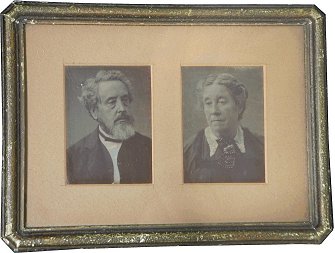 Just a week before the Liberty Seated Collectors Club's big SeatedFest II convention at the Whitman Baltimore Expo, the family found one! A small 4x6-inch frame with photos of William and his wife, Anna Maria Barber! They are positively identified by Edith Barber's hand-written note on the back of the frame. Edith was Charles Barber's daughter.
Just a week before the Liberty Seated Collectors Club's big SeatedFest II convention at the Whitman Baltimore Expo, the family found one! A small 4x6-inch frame with photos of William and his wife, Anna Maria Barber! They are positively identified by Edith Barber's hand-written note on the back of the frame. Edith was Charles Barber's daughter.
Like the other images of the Barbers, the family has graciously allowed this new photo to be published. The high-resolution photo has been made available for download and publication on the websites of both the Liberty Seated Collectors Club (LSCC) and the Barber Coin Collectors' Society (BCCS). It is available in multiple formats for authors, researchers, and catalogers.
Readers should also be reminded that the many new photos of Charles Barber have also been made available for download at the BCCS website.
LSCC - William Barber photo:
http://www.lsccweb.org/WilliamBarber-photo.shtml
BCCS – Barber photos:
http://www.barbercoins.org/New-Barber-images.shtml
 In the meantime, I am pleased to present Chief Engraver William Barber as you have never seen him before:
In the meantime, I am pleased to present Chief Engraver William Barber as you have never seen him before:
This is great news. Last week's Seated Fest was a super event. See my Numismatic Diary elsewhere in this issue for some photos. -Editor
To read earlier E-Sylum articles, see:
WILLIAM BARBER PHOTO SOUGHT (https://www.coinbooks.org/
esylum_v09n43a06.html)
QUERY: IMAGES OF ENGRAVER WILLIAM BARBER SOUGHT (https://www.coinbooks.org/
esylum_v14n03a11.html)
WILLIAM AND CHARLES BARBER EXHIBIT AT WHITMAN EXPO (https://www.coinbooks.org/v21/
esylum_v21n40a17.html)
SEATED FEST II BALTIMORE 2019 (https://www.coinbooks.org/v22/
esylum_v22n08a16.html)

BURNS LIBRARY AT THE ANA NATIONAL MONEY SHOW
The ANA National Money Show is getting closer. Bibliophiles and serious collectors alike will enjoy visiting the Burns Library. Here's the press release and images courtesy of the Pennsylvania Association of Numismatists (PAN). -Editor
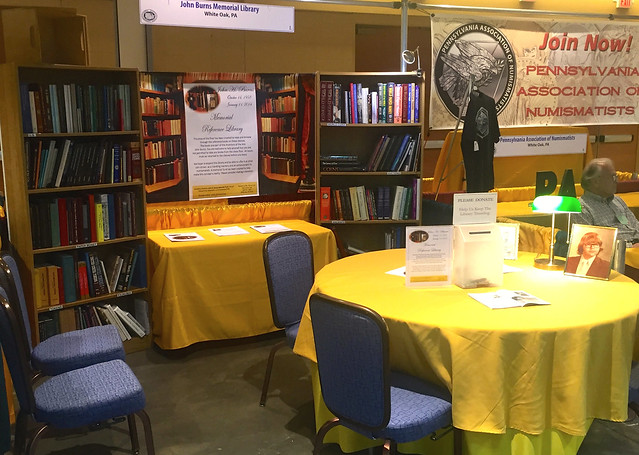
Burns Library set up at the CSNS Show 2014
The John Burns Memorial Numismatic Reference Library will be part of the American Numismatic Association National Money Show to be held on March 28 – 30, 2019 at the David Lawrence Convention Center Pittsburgh, PA.
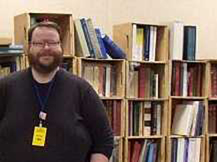 John Burns was a popular numismatic book dealer that was often seen at many coin shows in the eastern part of the country. His last coin show was five years ago when he suddenly passed away at the young age of 55 from heart problems while attending the FUN show in Orlando FL.
John Burns was a popular numismatic book dealer that was often seen at many coin shows in the eastern part of the country. His last coin show was five years ago when he suddenly passed away at the young age of 55 from heart problems while attending the FUN show in Orlando FL.
John's untimely passing prompted the Pennsylvania Association of Numismatists (PAN) to do something special in memory of this beloved western Pennsylvania resident. His estate administrator Patrick McBride with longtime friend E-Sylum editor Wayne Homren decided that a reference library for collectors and dealers to use at the PAN coin shows would be a fitting tribute. Requests were made to bring it to other coin shows and the library has traveled to the 2015 ANA World's Fair Money in Rosemont, Chicago and the 2014 Central States Numismatic Society coin show in Schaumburg, IL. It is fitting on this fifth anniversary of John's death that this library will be at the ANA National Money Show.
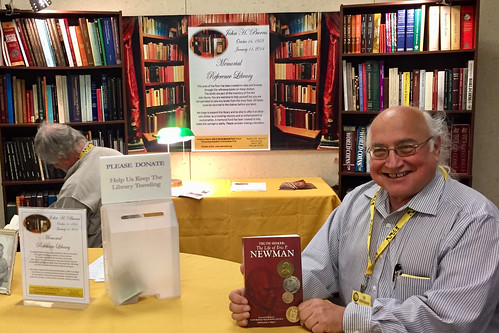
Burns Library Curator Ed Krivoniak holding a recent book donation, "Truth Seeker: The Life of Eric P. Newman" by Augsburger, Burdette, Orosz
The reference library will be set up in the club midway area of the show floor. It has grown to nearly 400 books with generous donations from friends and dealers with recent significant additions from dealers Richard Cross and Harold Weitz. It is a designated quiet spot to sit and browse during the coin show. The books are not permitted to leave the show floor area.
Dealers have used it to take a reference book back to their table to look up a coin, medal, or paper money item. Collectors have used it to do the same before making a decision about a show floor purchase. Exhibit judges have used it to confirm information while judging competitive exhibits. Others have just enjoyed sitting and resting their weary feet and regaling stories about John's life and impact he had on the numismatic community. View the library list or learn more by going to www.PANcoins.org and clicking the Burns Library link.
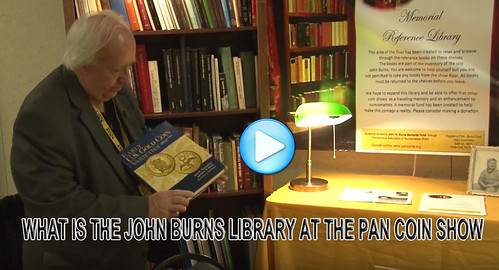
Pat McBride explaining the Burns Library concept
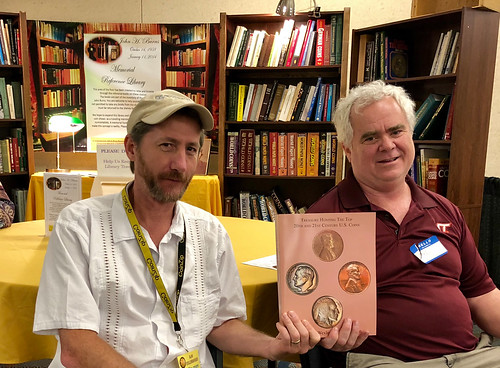
Book donation by author Kevin Flynn (at right) holding latest book "Treasure Hunting The Top 20th and 21st Century U.S. Coins" by Wexler and Flynn. Seated at left is Alan Stullenbarger of CoinZip.com
For more information, see:
Burns Library (https://pancoins.org/john-burns-memorial-reference-library/)
John Burns Memorial Library Available at PAN Coin Show (https://nnp.wustl.edu/library/book/549175)
NEWMAN PORTAL ADDS SPURRIER VIDEO: "THE CENT"
The latest addition to the Newman Numismatic Portal is a video on "The Cent". Project Coordinator Len Augsburger provided the following report. -Editor
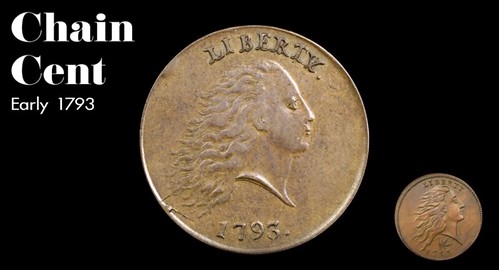
Lianna Spurrier continues her series of videos aimed at young numismatists, and the latest entry "The Cent," has been added to Newman Portal. This video traces the evolution of the U.S. cent from its inception to the present day. You won't learn about the vagaries of Sheldon varieties here, but you will become familiarized with the major design types over the years, and hopefully be encouraged to dig further.
Spurrier, a National Merit Scholar, is currently a senior at Morehead State in Kentucky, majoring in convergent media. She brings a fresh and welcome eye to the subject, and we look forward to her continued contributions to the field.
Link to Lianna Spurrier videos on Newman Portal:
https://nnp.wustl.edu/library/multimediadetail/529486

NUMISMATIC HOLMES FANS TO MEET IN PITTSBURGH
Greg Ruby publishes The Fourth Garrideb blog about the numismatics of Sherlock Holmes. The Garridebs are hosting a dinner at the upcoming ANA National Money Show in Pittsburgh. -Editor
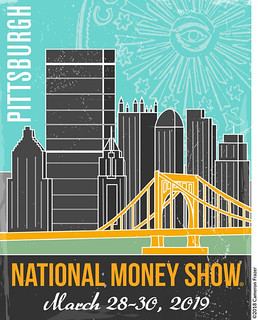 The American Numismatic Association is bringing its National Money Show to Pittsburgh, Pennsylvania in late March. The Fourth Garrideb will also be in Pittsburgh and will hold its Numismatic Friends of Sherlock Holmes Dinner on Friday, March 29, 2019 at 7:00 p.m.
The American Numismatic Association is bringing its National Money Show to Pittsburgh, Pennsylvania in late March. The Fourth Garrideb will also be in Pittsburgh and will hold its Numismatic Friends of Sherlock Holmes Dinner on Friday, March 29, 2019 at 7:00 p.m.
The Sharp Edge's Bistro on Penn, 922 Penn Street, is the venue for our dinner, and is a very short walk from the David L. Lawrence Convention Center, site of the National Money Show. Bistro on Penn combines the comfort of a neighborhood bar with the polished feel of a Belgian bistro, offering an unparalleled beer selection and a unique dining experience. There are 35 taps and 200+ bottles of beer to choose from. You can check out the food menu by clicking HERE .
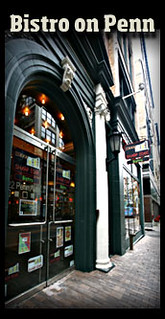 There is no program, quizzes or story discussions for this dinner. Maybe a toast or two, if someone feels adventurous. Mostly the evening is about good food, good camaraderie and good conversations. An attendee at one of our dinners in 2017 commented that "It has been a long time, if ever, that I have enjoyed the company of ‘strangers' at dinner who were so bright, so engaging, and so talented."
There is no program, quizzes or story discussions for this dinner. Maybe a toast or two, if someone feels adventurous. Mostly the evening is about good food, good camaraderie and good conversations. An attendee at one of our dinners in 2017 commented that "It has been a long time, if ever, that I have enjoyed the company of ‘strangers' at dinner who were so bright, so engaging, and so talented."
The Fourth Garrideb has a tradition of issuing a souvenir at these dinners and this year will be no exception. All attendees will receive this item.
We hope you can join us for this evening. We ask that interested folks RSVP to Greg@FourthGarrideb.com by Monday, March 25 so that we can make the necessary arrangements with the restaurant. Again, there is no need to pay in advance.
To read the complete article, see:
TFG To Hold Numismatic Friends of Sherlock Holmes Dinner in Pittsburgh on March 29 (https://fourthgarrideb.com/2019/01/18/tfg-to-hold-numismatic-friends-of-sherlock-holmes-dinner-in-pittsburgh-on-march-29/)
THE BOOK BAZARRE
NOTES FROM E-SYLUM READERS: MARCH 10, 2019
Don't Be Shy: Contribute to The E-Sylum
Paul Bosco writes:
A recent issue included long remembrances of Jim King, by Jeff Rock and Bill Rosenblum. I had penned something that ran the week before. Jeff & Bill's submissions were of much greater value than mine.
You're reading this from someone who has been called The Greatest Writer in the History of the English Language. True, only in the 50-Words-and-Less (or Phone Answering Machine) category, and only by himself, but there is a legitimate point here.
Without suggesting that Jeff and Bill are neophytes at writing, it's usually the case that people write best when they write on subjects that matter the most to them.
Many E-Sylum readers must have significant insights into matters under discussion in The E-Sylum. I encourage such readers to take to the keyboard and share. You can only make this fine publication better, by furthering discussion, spreading information and diversifying sources.
Indeed. Not everyone is comfortable with writing, which explains why this publication is the same as all others in that contributions come from the few for the benefit of the many. Please do take a minute to chime in on topics you see here. You don't have to be the world's expert on a topic, just someone with an interest. If you have a question, just ask it - often many other readers are thinking the same thing. Questions and observations are what drive the discussion forward. Fuggetabout grammar, spelling and punctuation - I'm here to edit and I always send a draft for review before publishing. Relax - it'll be fine. I'm looking forward to hearing from more of you in the upcoming weeks. -Editor
To visit Paul's web sites, see:
http://www.pauljbosco.com/
http://www.artdecomedals.com/
http://pauljbosco.blogspot.com/
A Golden Age of Numismatic Editorship?
Paul Bosco writes:
I see that Dave Harper (Numismatic News and other Krause Publications magazines) is retiring, after a mere 45 years. The longevity of numismatic editors is considerable. Russ Rulau, Margo Russell, Beth Deisher, Bill Gibbs, Barbara Gregory.... I think one reason is that many are women, who have sensed they have an important job and could work to make it moreso -- while getting more credit for the product than is usually the case for working women.
I think, though, that there is probably something about Numismatics, in the hard data, the long history and the personal stories, that keep editorial work rewarding. Also, the publishers (Amos, Krause, the ANA...) may have been more beneficent than corporate, actually fond of the hobby they serve and draw profits from, in an age when this is no longer the norm.
I wonder what numismatic writers and editors think? Are we leaving a Golden Age in numismatic editorship, or are we going to be OK?
If you look beyond national publications to specialty numismatic club journals, the tenure of many editors is equally remarkable. For example, John Coffee edited The Fare Box, the journal of the American Vecturist Association, for over 50 years. As E-Sylum editor I've been working with the numismatic community for over 20 years to date, and I just never seem to run out of interesting topics to cover. That and the generosity and friendship of the greater community are what keep me going every week. Despite the work involved, it's fun, too.
So what do others think? Is a Golden Age behind us, or everlasting? -Editor
To read the earlier E-Sylum article, see:
NUMISMATIC NEWS EDITOR DAVE HARPER RETIRES (https://www.coinbooks.org/v22/esylum_v22n07a05.html)
Thief Dumps Coin Collection into CoinStar Machine
Regarding the story of the thief who cashed in stolen proof coins in a supermarket change machine, Bill Rosenblum writes:
The story is almost unbelievable. But 30-40 years ago my Dad's house was broken into and someone stole about 50-100 US Proof sets. We figured whoever stole the sets sold them for face or just used them as as change.
He said it was the first, and last, time he ever locked his doors. And he did it at my suggestion. Which is probably true. I was always harping on him to at least lock the doors.
This brings back bad memories. When I was a kid a neighborhood "friend" broke into our house and took my nascent coin collection. We later learned he'd broken Ike dollars out of the mint packaging and rolled them across the schoolyard before his spending spree. His parents punished him big time and gave me full restitution. That's when I got my first safe deposit box. -Editor
To read the complete article, see:
A North Palm businessman says a ‘friend' now in custody robbed him of items totaling $350,000. (https://www.palmbeachpost.com/news/20190222/did-rare-stolen-coins-end-up-in-supermarket-change-machine-victim-wonders)
The Stamp Money out of Politics Overstamp
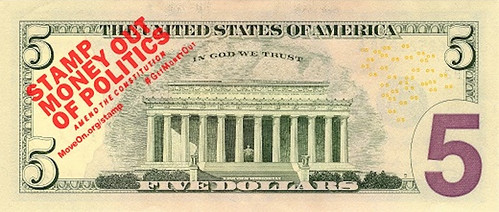
Gary Beals forwarded an email about another banknote-stamping campaign from MoveOn.org. -Editor
Ben and Jerry here, the ice cream guys.
H.R.1, the For the People Act, has just been introduced in Congress. It's the best thing to happen for getting money out of politics and ending voter suppression since our Stamp Stampede protest began way back in 2012.
Over 100,000 of us have been making our voices heard by—totally legally—rubber-stamping paper currency with the "Stamp Money Out of Politics" message. Making your voice heard loud and clear like that is what makes all the difference. As Abraham Lincoln said, "Public sentiment is everything. With public sentiment, nothing can fail. Without it, nothing can succeed." And every stamped bill is seen by 875 people as it gets passed around.
I keep an eye on my banknotes for chopmarks or other stamps like this, but I've not seen this one. Can anyone report a sighting in the wild? -Editor
For more information, see:
BEN & JERRY'S STAMP STAMPEDE: STAMP MONEY OUT OF POLITICS (https://store.moveon.org/products/ben-jerrys-stamp-stampede-stamp-money-out-of-politics)
Banque De L'Indochine 500 Piastres Issue Date
Howard Daniel writes:
I have been continuing to thin out my personal library and donate or sell what I do not need to keep in hard copy. I just came across a US Department of Commerce Foreign Commerce Weekly of August 23, 1941. It mentions "New notes of 500 Piastres denomination were placed in circulation during April." This is completely new information! I have not seen anything before except the year of 1939 without any source. So we now have a new date for the issuing this 500 Piastres note!
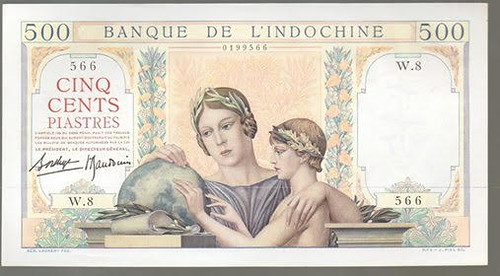
Thanks - great information. I brought this to the attention of Owen Linzmayer, editor of The Banknote Book. -Editor
Another 1896 Argentum Universale One Talent Offered
regarding the 1896 Argentum Universale One Talent piece, Mark Borckardt of Heritage writes:
Another one has surfaced. This one will appear in our 2019 Central States sale next month.
Mark provided the draft catalog description - I'll publish that next week. Stay tuned. -Editor
To read the earlier E-Sylum article, see:
1896 ARGENTUM UNIVERSALE ONE TALENT LOCATED (https://www.coinbooks.org/v20/esylum_v20n27a13.html)
Information on Lutwyche and Counterfeiting Tokens Sought
Michael Dlugosz writes:
I was looking for information on Lutwyche and counterfeiting tokens. I read in Selgin's book a few paragraphs on the subject and traced that back to a reference to an article (perhaps) that Ken Elks authored in 2005. I asked Selgin if he happened to recall what the source was but he wasn't sure as it had been a long time and he had discarded his notes. Can anyone tell me where the referenced source was published, or put me in touch with Ken Elks?
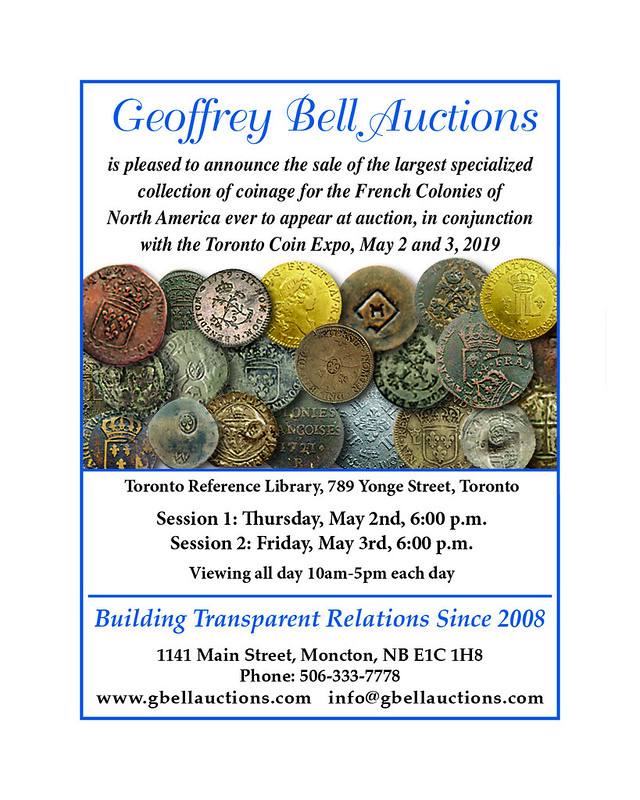
THE WEDDING MEDAL CHRONOGRAM
Herman Blanton writes:
We had an article with an excellent description of a chronogram in the Numismatics International magazine the NI Bulletin for July / August 2015. Readers interested in Numismatics International may reference the website numis.org.
The article is "The Wedding Medal of Emperor Leopold I and Eleonore" by Paul Oostervink. The medal has a chronogram and the article well explains it. The article is on pp. 108-112 at the Newman Portal link below. I think you'll find the images beautiful.
Thanks for the great reference! Here's a very short excerpt. -Editor
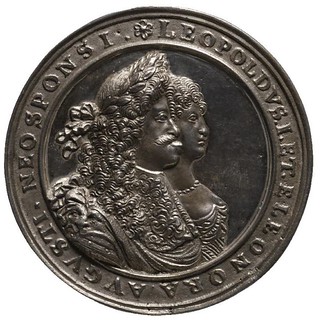

This medal was struck to celebrate their wedding in 1676; today it resides in the coin cabinet of the KHM in Vienna. The medallist was Johann Permann.
Obverse inscription:
LEOPOLD VS.LET.ELEONORA.AVGVSTLNEOSPONSL
(Leopold I and Eleonore, the illustrious newly-married emperors)
Reverse inscription:
VIrtVte.atqVe.MaIestate ConsILIo.et.InDVstrIa.
(Resolute and yet majestic, thoughtful and dedicated)
Detecting the hidden date (chronogram) in the reverse legend:
In the legend on the reverse there is a hidden number, composed of letters that can represent a value in Roman numerals. They are easily found as they appear in larger type size. The reverse order rule discussed above (deducting small numbers which appear before large numbers) does not apply. All letter-numbers are added together. If V comes before L, it is not 45 (L-V) but 55 (V +L).
To read the complete article, see:
https://archive.org/details/NIB2015JulAugVol50Nos07to08/page/n3
To read the earlier E-Sylum article, see:
VOCABULARY TERM: CHRONOGRAM (https://www.coinbooks.org/v22/esylum_v22n08a17.html)
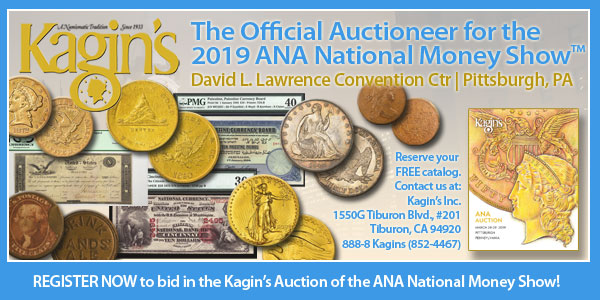
GUTTAG NEW YORK STORECARD CENSUS
Regarding Robert Rightmire's question about the 1927 Guttag Brothers storecard, Pete Smith writes:
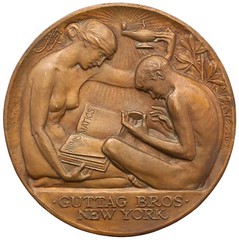 I have eight different Guttag Brothers storecards but not the one shown in The Numismatist in June 1927. I was amused with the comment that this may have been the first numismatic storecard. Some of the Guttag pieces are dated 1923.
I have eight different Guttag Brothers storecards but not the one shown in The Numismatist in June 1927. I was amused with the comment that this may have been the first numismatic storecard. Some of the Guttag pieces are dated 1923.
I consider 1858 to be the date of the first American numismatic storecards. The first ones were issued in the name of an individual. Off hand I don't recall when the first one was issued in the name of a company.
Joseph Alan Barnosky writes:
I have one. Saw the articles on point in The E-Sylum, and, my eye caught, off to eBay it was. Saved the search, and time did the job.
Harry Waterson writes:
Attached are my images of the Guttag Rare Coins varieties. These are the four I know of. I do not own any of these pieces. I just got caught up by the number of variations. The one I have noted as unlisted is a mule of two Guttag obverses.

Guttag Bros Rare Coins

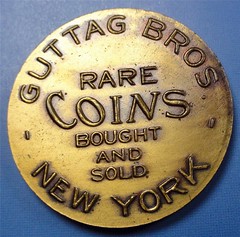
Guttag Bros Coin Week Originated 1923
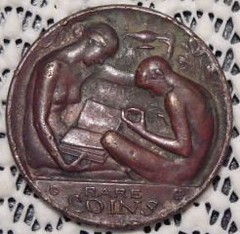
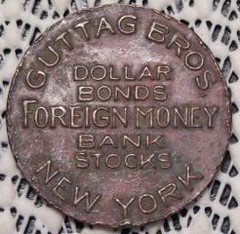
Guttag Bros Rare Coins Alternate

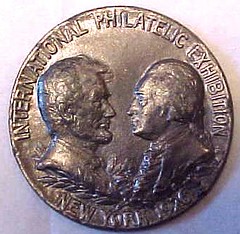
Guttag Bros unlisted
Thanks, everyone! -Editor
To read the earlier E-Sylum article, see:
NOTES FROM E-SYLUM READERS: MARCH 3, 2019 : Query: Guttag New York Storecard Sought (https://www.coinbooks.org/v22/esylum_v22n09a12.html)
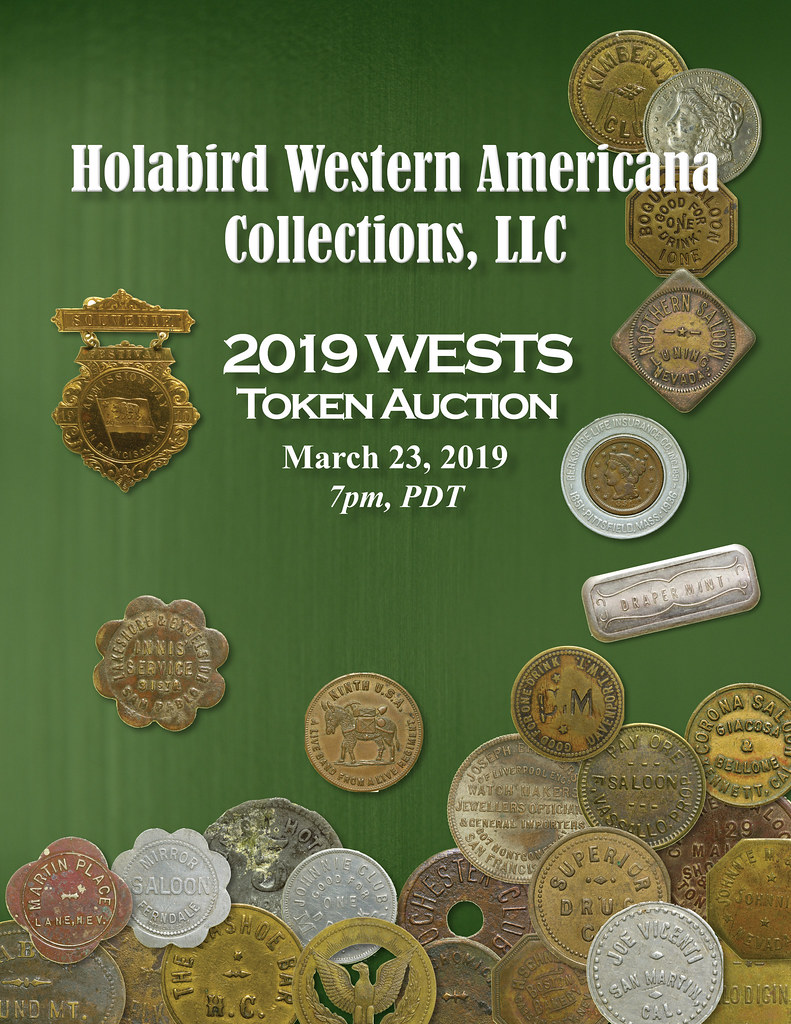
ENCASED COIN STATE GRAND LODGE RICHMOND, VA
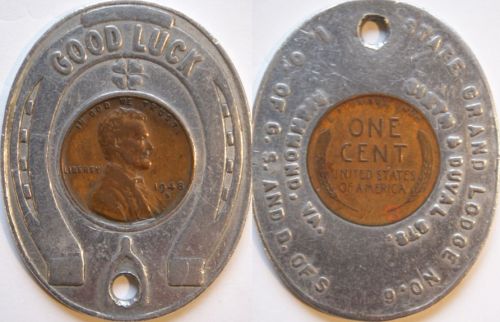
Regarding Bruce Perdue's mystery encased cent, Tom Lovelace writes:
Independent Order of Good Samaritans and Daughters of Samaria. Credit the internet. I just looked it up.
Gerry Tebben writes:
Bruce's encased was issued by the Independent Order of Good Samaritans and Daughters of Samaria, a temperance organization.
I found this description on the Philadelphia Area Archives Research Portal.
Harry Waterson found this as well. -Editor
The Independent Order of Good Samaritans and Daughters of Samaria was established in New York City in 1847 as a temperance group and a beneficial society. Although founded by white men and women, within a few years African Americans began joining the order, for the most part segregated into separate lodges. Whites began withdrawing from the order around the time of the Civil War, and before long it was an exclusively African American organization. It was probably one of the largest African American fraternal groups.
The motto of the Order of Good Samaritans and Daughters of Samaria was, "Love, Purity, and Truth." Its objects included promoting temperance reform, securing charity for the unfortunate, and burying deceased members of the order. Membership was open to women between the ages of 15 and 50, and men between 18 and 50. Abstinence from "intoxicating drinks" was required; members found violating this requirement on one occasion would be suspended, and upon a second violation be expelled. Members could also be expelled for betraying secrets of the order.
A Philadelphia branch, Golden Star Lodge, No. 4, of the Independent Order of Good Samaritans and Daughters of Samaria, was organized November 17, 1880 under the jurisdiction of the Right Worthy District Grand Lodge, No. 2, of Pennsylvania and Delaware. That year, the national order counted around 20,000 members in up to 375 lodges located across the United States, Canada, and the Caribbean.
To read the complete article, see: Records of Golden Star Lodge No. 4 of Independent Order of Good Samaritans and Daughters of Samaria (Philadelphia, Pa.) (http://dla.library.upenn.edu/cocoon/dla/pacscl/ead.html?
id=PACSCL_HSP_AAMP10&fq=top_repository_facet
:%22African%20American%20Museum%20in%20Philadelphia%22&)
Rich Bottles Jr writes:
Please let Bruce Perdue know that his maverick encased cent from last week's E-Sylum is likely from "State Grand Lodge No. 6, Independent Order of Good Samaritans and Daughters of Samaria of Virginia."
Reference link is: Annual report of the Commissioner of Insurance of Virginia .
Julia Casey writes:
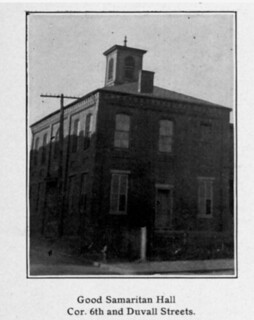 The Independent Order of Good Samaritans and Daughters of Samaria, State Grand Lodge, No. 6 of Virginia was located at the "N.W. Cor 6th & Duval Sts." at that time (and apparently for many years after based on the 1948 date of Bruce Perdue's encased cent).
The Independent Order of Good Samaritans and Daughters of Samaria, State Grand Lodge, No. 6 of Virginia was located at the "N.W. Cor 6th & Duval Sts." at that time (and apparently for many years after based on the 1948 date of Bruce Perdue's encased cent).
I also found an image of "Good Samaritan Hall" at that address. Located in the archives of the Library of Congress. Image 38 of Souvenir views: Negro enterprises & residences, Richmond, Va.
Thanks also to John Byers and others who wrote in. Everyone contributed a piece of the final puzzle. It's interesting to see that this turned out to be a piece of African-American numismatica. It would be great if someone would tackle writing a catalog of this material. -Editor
To read the earlier E-Sylum article, see:
NOTES FROM E-SYLUM READERS: MARCH 3, 2019 : Query: Richmond, VA Encased Coin Info Sought (https://www.coinbooks.org/v22/esylum_v22n09a12.html)
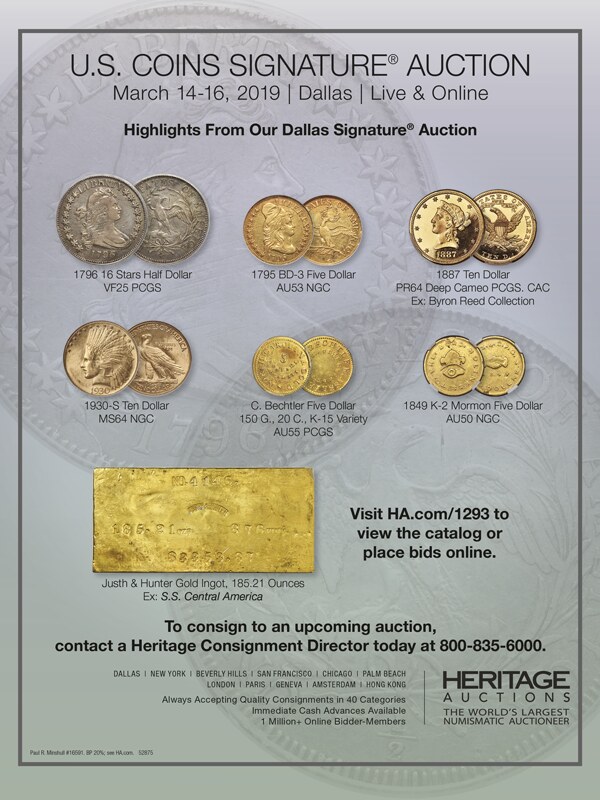
GEOGRAPHY, METALLURGY BOOKS AVAILABLE
Howard Daniel has some non-numismatic books available for free to a good home. -Editor
The following books have been pulled from my personal library and need a new home because I no longer need them. I will mail them at no cost to the first person who emails me that they want them. They were bought at Ace Books & Consignments in Culpepper, VA many years ago. They were owned by a young man who went to school in Winchester, VA right after the Civil War. Please email me (Howard A. Daniel III) at HADANIEL3@MSN.COM.
A Treatise on Metallurgy: Comprising Mining, and General and Particular Metallurgical Operations, by Frederick Overman, 5th Edition, and printed by D. Appleton & Co., New York and London, in 1864 with 375 engravings and 723 pages. The book is complete and the pages are in excellent condition but the spine is broken.
Warren's Common School Geography, by D.M. Warren, Last Revised Edition, and printed by H. Cowperthwait & Co., Philadelphia, PA in 1866 with many engravings and maps of the USA and the world. The book is still bound but the spine is missing with the pages in excellent condition.
Mitchell's New Intermediate Geography, A System of Modern Geography for the use of Schools and Academies, by S. Augustus Mitchell, Revised Edition, and printed by E.H. Butler & Co., Philadelphia, PA in 1868 with 23 copper-plate maps of the USA and the world. On the last blank page is a rubbing of an 1853 Half Dime! Still bound and complete with pages in excellent condition.
Mitchell's New School Atlas, by S. Augustus Mitchell, and printed by E.H. Butler & Co., Philadelphia, PA in 1870 with 44 copperplate maps of the USA and the world. Still bound and complete with pages in excellent condition but covers are scuffed.
I wouldn't be surprised if these are snapped up quickly - the maps alone are likely valuable as decorative prints. -Editor
VOCABULARY TERMS: CAST, CASTING
Dick Johnson submitted these entries from his Encyclopedia of Coin and Medal Terminology. Thanks! -Editor
Cast, Casting. Made from molten metal poured into a mold. Metalcasting is the world's oldest metal technology, spanning more than 5,000 years in man's history, yet it is as modern and necessary as the most recent model or medallic item. The ease in which molding can be done is why artists use this technique to cast designs in their own studios (see also plaster casting) and yet why a giant industry exists for casting metal parts from the size of pins to steamship propellers.
There are several casting techniques – and there has been more development in this field in the last 50 years than in all the previous 5,000. Yet techniques from prehistoric times, as sand casting, are still in common use today.
Patterns for coin and medal designs have been cast in metal (then reduced by pantograph to create dies the required size as small as a dime). Also casting has been used for making the end products, as many cast art medals – and coins from early China – attest.
In contrast to the foundry casting industry, medallic casting is small by comparison. Coins and medals are small size, their shape is generally flat, and they lack complex forms. They have no undercuts and are the simplest form of relief casting. Medallions larger than six inches – because of the limitations of size in diestriking in presses – are always cast. Medallic objects, often in somewhat more complex form, are usually cast. Thus the medallic field has been casting glyptic objects since Pisanello created the first cast medal in 1438.
Cast Coins, Medals and Plaques
As such, cast coinages have been made – particularly in China where coins were made by casting several at a time connected to a stem, called a tree. They were placed in use by breaking off the coins as needed. In modern times most cast coins are counterfeit. They are made by permanent mold casting, with molds that can be broken apart for the removal of the cast piece then used to cast again.
Cast medals are somewhat more common and genuine. Such cast medallic items sometimes have only one side (called single-sided), but may have two sides, (called double sided if both sides are in the mold), or may have two sides where two single-sided cast medals joined together (called cast double). Plaquettes are sometimes cast (if not diestruck), plaques are always cast because of their larger size (over eight inches). Thus plaques, always intended for display, have a flat back with some means for hanging or upright support cast on back.
Cast versus Struck Surfaces
Metal objects that are cast have physical characteristics different from struck objects. The surface of both types is most characteristic. Cast surfaces usually exhibit a grainy appearance, and are more rounded than the sharp angular detail of a struck or coined metal piece.
Generally a cast surface is not completely smooth but may exhibit the roughness of the surface of the mold or contain pits (blowholes from escaping occluded gas). Struck surfaces are more likely to be smooth with no inherent imperfections.
Cast lettering appears rounded and less distinct. Struck lettering can be sharper and more angular at the top of the letters and where the sides of lettering meet the field.
Casting is a slow operation, but can be speeded up by diecasting, forcing hot metal into a die mold (but only metals with a low temperature melting point can be diecast – as white metal zinc alloys). For production runs requiring high production speeds, coins and medals are required to be struck. Diestriking in modern presses is preferred to casting for another important reason – far more intricate detail can be reproduced by dies than by molds.
Cast Counterfeits
Because counterfeiters cannot usually afford the very large expense of die making equipment and stamping presses – in addition to the artistic requirements of the original patterns, dies and tooling – coins are more often counterfeited by casting. Once the counterfeiter has an original coin, making a mold, as mentioned above, is fairly simple. Casting from that mold is also easy, although it will result in several obvious characteristics (which numismatists call diagnostic detail): slightly smaller size than the original (shrinkage), a surface of varying porosity, and a small loss of some detail and definition.
More recently counterfeiters have been making dies or molds by edm (but this process has a characteristic pock-marked surface evident under magnification, unlike the smooth surface of conventional die making methods or cast porosity).
Medallic Casting Techniques
Casting techniques that could be used to make medallic items include lost wax (also called cire-perdue, waste wax, precision casting and investment casting); die-cast, diecasting (where metal is shot into permanent molds); shell mold or ceramic mold (with very smooth sides of the mold wall); flexible mold or rubber mold (for items of high relief and undercuts); and permanent mold casting (for multiple casting). Sand casting is not suitable for medallic work because of the great porosity and inability to cast minute detail.
Looking for the meaning of a numismatic word, or the description of a term? Try the Newman Numismatic Portal's Numismatic Dictionary at: https://nnp.wustl.edu/library/dictionary
Or if you would like a printed copy of the complete Encyclopedia, it is available. There are 1,854 terms, on 678 pages, in The Encyclopedia of Coin and Medal Technology. Even running two a week would require more than 19 years to publish them all. If you would like an advance draft of this vital reference work it may be obtained from the author for your check of $50 sent postpaid. Dick Johnson, 139 Thompson Drive, Torrington, CT 06790.
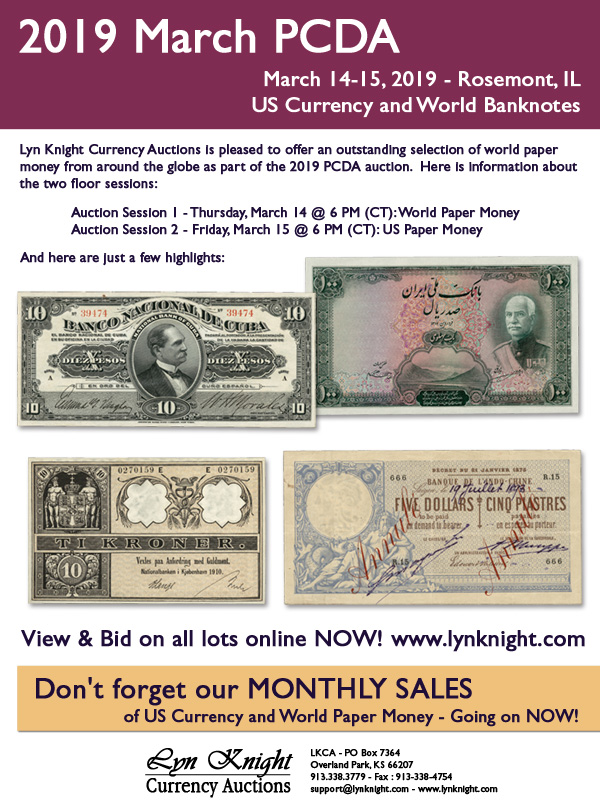
DR. ALBERT LEROY FISHER (1845-1918)
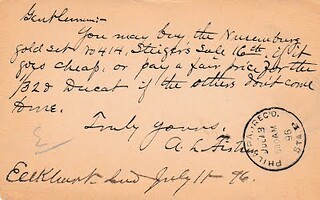 Dr. Albert Leroy Fisher (1845-1918), was born in Bristol, Ontario County, New York, the last of eight children, on August 1845, son of Jeremiah Fisher (1799-1861), a veterinarian and Altha Wilson Fisher (1804-1867). His family traces their ancestry to Anthony Fisher who came to Dedham, Massachusetts from Norfolk, England in 1637. His grandfather Nathaniel served in the Revolutionary War.
Dr. Albert Leroy Fisher (1845-1918), was born in Bristol, Ontario County, New York, the last of eight children, on August 1845, son of Jeremiah Fisher (1799-1861), a veterinarian and Altha Wilson Fisher (1804-1867). His family traces their ancestry to Anthony Fisher who came to Dedham, Massachusetts from Norfolk, England in 1637. His grandfather Nathaniel served in the Revolutionary War.
He was raised at Bristol. He attended East Bloomfield Academy. His favorite pastime was hunting a sport in which he won many awards and medals. He began to develop an interest in numismatics about 1890 or 1891.
In 1871, he graduated the Hahnemann Medical School, Philadelphia.
He sometimes signed his name A. Leroy Fisher but in numismatics he was generally referred to as A. L. Fisher.
Fisher became a physician and specialized as a pediatrician.
He served as Vice President of the Elkhart County Historical Society.
He joined the ANA in February 1893, and became Member No. 130. During the renumbered he then becameANA Member No. 46.
He attended the ANA 1893 Convention held at the Chicago World's Fair.
There are numerous specimens of correspondence from Fisher to the Chapman Brothers found in the Lupia Numismatic Library. From these we learn he was a steady client of the Chapman Brothers with regular purchases that average about $11 each. His conservative buying habits reflect the C+ rating of his November 8, 1907 coin auction sale given him by John Adams.
From 1894 to 1904 he served as the Treasurer of the ANA.
At the ANA Annual Convention held at Detroit he read a paper "A Novice Among the Coins".
In March 1899, he advertised in The Numismatist that the was looking for the best 1804 cent that $15 could buy.
He consigned his coin collection to Ben G. Green, to be sold at auction on November 8, 1907.
He died of cerebral hemorrhage on April 23, 1918. He was cremated and his urn placed in Gracelawn Cemetery, Elkhart.
Catalogue of the Choice and Valuable Collection of Rare Old Pistols and Guns Formed by the Late Dr. A. L. Fisher of Elkhart, Indiana: Also a Collection of Old American Lamps and Other Antiques, Etc.; To Be Sold at Auction Tuesday Morning and Afternoon, July 23rd, 1918. Nos. 1 to 321 of this catalogue, being Dr. Fisher's collection, were catalogued by Mr. W. A. Lawrence, of Elkhart, Indiana.
To read the complete article, see:
FISHER, DR. ALBERT LEROY (https://sites.google.com/a/numismaticmall.com/www/numismaticmall-com/fisher-dr-albert-leroy)
The entire inventory of the Lupia Numismatic Library is for sale. Individual items will be available before the remaining archives are broken up into parcels sold at philatelic auctions in the U. S. and Hong Kong. Check NumismaticMall.com frequently as dozens of new items with estimates will be posted daily until everything is sold.
All inquiries will be given prompt and courteous attention. Write to: john@numismaticmall.com .
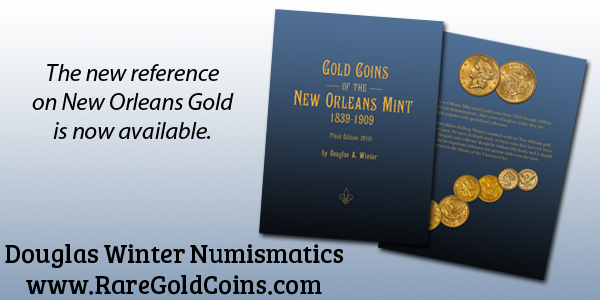
HARVEY STACK'S NUMISMATIC FAMILY, PART 39
Harvey Stack's blog series focuses on living in a numismatic family. Here is part 39. Thanks, Harvey -Editor
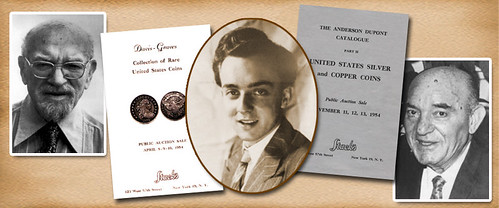
In 1965, the coin market became very hectic, as people became more aware that the change in their pockets could be more valuable than the face value printed on it. So daily, without a break, we had offers to buy silver, at a "hyped up price." This was fed by notices from the Treasury that one could not melt these coins, and that there might be redemption beyond face value. The Treasury implied that, after studying the ongoing confusion, they might consider approving in the future, the melting of the silver coins for their content.
Several prominent people created a new marketplace for coins. Dr. Jerekke, who owned Iron Mountain Depository, started buying up silver coins for the future. There were groups who pooled their wealth and speculated with their precious metal friends to drive up the demand for silver. The price of silver began to rise, but it wasn't until a new regulation was passed that they were able to sell at a profit some of the silver they had accumulated. The silver buyers were led by the famous Hunt Brothers of Texas, who spent their fortune buying up silver. The huge uproar meant coin dealers around the country were overwhelmed with questions about silver that interrupting their daily work. While many made money buying and selling silver and even speculating, this was all a real distraction from the usual numismatic business that still had to be done.
Also causing a distraction to our regular business were Silver Certificates, notes that were issued with silver backing them, that became another speculative item. As silver was removed from the nation's coins, the U.S. had to redeem these notes. Many billions were still in circulation, but in order to control demand, the Assay Office would not redeem these notes unless $10,000 face value was delivered to them. This created another secondary market. A buyer would pay a small premium initially for each note, and bundle them together until the face value reached $10,000. The one who submitted the notes for redemption made the greater profit and this redemption was more lucrative than trading silver on the precious metal market.
So, with the silver market going crazy and with the general public all hyped up about making money from our Treasury, you can imagine the activity that was created.
In addition, during 1965, the Office of Gold and Silver Operations (OGSO) was short of help and were very slow in issuing import licenses for gold coins, sometimes causing a wait of months to see if the OGSO would issue a license. For Stack's this caused problems, not only when we wanted to bring coins into the U.S. for auction, but also when we were looking for items to enhance our clients' collections. This was true of when we were looking for things to add to Josiah K. Lilly's collection. When we found something, we were never sure if the OGSO would allow it into the country.
Due to these difficulties, our lawyers in Washington filed papers, suing the OGSO and the Treasury Department for actions without explanation. We had to file papers with our complaint and wait for an answer. The OGSO had 60 days to respond, and then our attorney had to respond. To the surprise of our attorneys, the Department did not have a judge or a hearing officer to hear our case and we had to wait until one was found. One was found in the Commerce Department; we filed our complaint with him and then had to wait for him to set a date, which was finally done for the early part of 1966.
To read the complete article, see:
Harvey Stack Remembers: Growing Up in a Numismatic Family, Part 39 (https://www.stacksbowers.com/News/Pages/Blogs.aspx?ArticleID=3307)
To read the earlier E-Sylum article, see:
HARVEY STACK'S NUMISMATIC FAMILY, PART 38 (https://www.coinbooks.org/v22/esylum_v22n08a19.html)

HONG KONG COIN SHOW EDUCATIONAL EVENTS
The Hong Kong Coin Show takes place March 29-31, 2019. A number of seminars and educational events are scheduled. Here is some information from the press release. -Editor

Seminars and exhibitions made their debut in the 4th Hong Kong Coin Show as a way to educate the public and nurture the next generation of numismatic enthusiasts. Participants were able to learn about the latest trends in the hobby as well as increase knowledge in specific areas. Always striving to improve, in the upcoming Coin Show, workshops will be limited to no more than five attendees, allowing participants to have easy communication with the professionals and to maintain a relaxing atmosphere.
Added to this year's show will be guided tours geared to university students, with the goal of increasing interest in numismatics in a younger generation. The tours will be held on the afternoon of the second day, 30 March 2019. They will focus on the fundamentals of the numismatic industry and the historical aspects of coins and banknotes. Some of the exhibitors will work with HKCS to introduce their collections to the students.
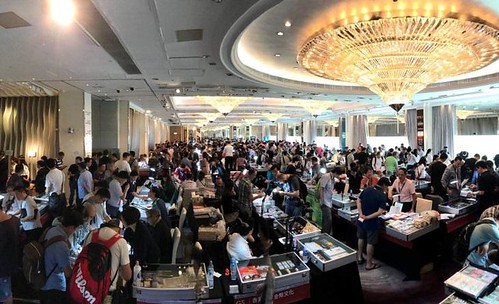
Twice each year, active coin dealers and collectors converge on the 18th Floor of The Mira Hotel in Hong Kong for an exciting numismatic event. The biannual Hong Kong Coin Show (HKCS) takes place in March/April and August and features not only buying and selling but also seminars, workshops, exhibitions, and a guided tour for university students. This well-attended event is organized by four partners: Stack's Bowers and Ponterio Co. Ltd., Spink & Sons Ltd., Shouxi.com and Coin-In-Coin, who are leading companies in their respective fields. The HKCS is regarded as the top numismatic show in Asia.
The 6th show takes place March 29-31, 2019.
Since its inaugural show in August 2016, HKCS has grown to include over 100 top numismatic organizations and individuals from over 45 countries and regions. The three-day show attracts over 5,000 visitors, providing a solid client base for trade and exchange of ideas. The HKCS helps to make Hong Kong a world-class numismatic hub for auctions and coin shows. The show sets the standard as Hong Kong moves forward as a world-class coin center and an enhancement to numismatic globalization.
If you are interested in more information on the top numismatic show in Asia or any of these special events, email info@hongkongcoinshow.com!
For more information, or to register, see:
https://www.hongkongcoinshow.com/
Here's some additional information about the auction from a Stack's Bowers mailing. -Editor
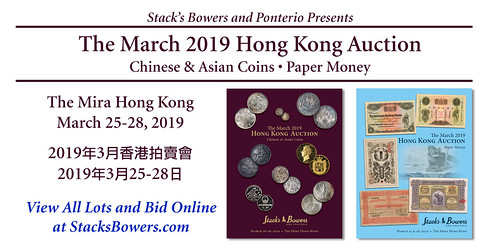
Hosted in conjunction with the Hong Kong Coin Show (HKCS), Stack's Bowers and Ponterio is pleased to present the Spring Hong Kong Coin and Paper Money auction. Destined to be a memorable event, the auction consists of over 3200 Asia-centric lots with items ranging from seldom-seen rarities to more available collector issues.
Within the Paper Money sessions, one of the most exciting offerings is a Chinese 2 Yuan Proof note (lot 50176) from 1975 that was never issued for circulated. Featured prominently in the art that graces the catalog cover, this extreme rarity is destined for an advanced collection of People's Republic of China issues. On the coin side, the unquestioned top lot is a stunning Thailand bullet money set of Rama V (lot 62386) that was originally presented to attendees of his birthday ceremony in 1880. Of those issued, only three intact sets are known today, making it the pinnacle of Thai numismatics.
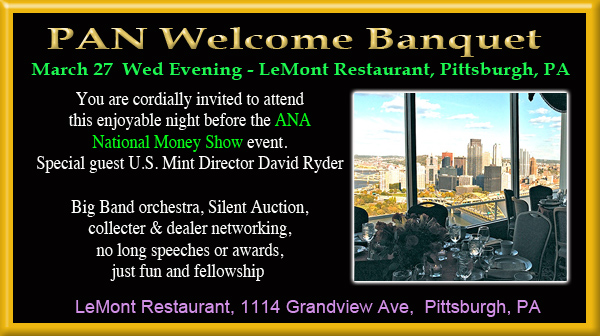
HERITAGE TO OFFER COOK CANADIAN COIN COLLECTION
The March 5, 2019 issue of Coin News from Heritage Auctions contained this announcement about their upcoming sales of the George Cook collection of Canadian coins. -Editor
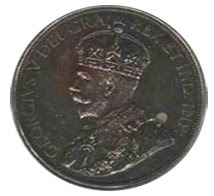 The world's most comprehensive and complete collection of Canadian coins ever assembled, including Canada's 1911 Silver dollar a 1921 50 Cent, "The King of Canadian Coins," heads to auction (and Canadian history) later this year.
The world's most comprehensive and complete collection of Canadian coins ever assembled, including Canada's 1911 Silver dollar a 1921 50 Cent, "The King of Canadian Coins," heads to auction (and Canadian history) later this year.
The late collector George Cook devoted more than 25 years to seeking out every major rarity issued by the Canadian government and successfully assembled one of the most significant numismatic collections in North America. In some cases, he owned the rarest of all specimens in the best condition and even possessed every example of special coins available for private ownership. Heritage Auctions, the world's largest auctioneer of rare coins, will present Cook's collection at the World's Fair of Money, Aug. 13-19 in Chicago, Illinois.
"I worked with George for over a decade helping him build his Canadian set and we became friends," said Cris Bierrenbach, Vice President of International Numismatics at Heritage Auctions. "George was one of the most focused collectors I have met in my 25 years in numismatics. He loved coins and he loved the challenge of finding the absolute best specimen for each denomination and date, and this will be evident once his catalog is published in July."
Cook did not let his humble beginnings stop him from building a successful and happy life in Canada. Leaving the poverty of post-war Europe behind, he immigrated to Canada in 1951 with little money, bringing hope for a better life and a box stuffed with his only belongings. With determination, he worked across the country and successfully graduated to managing some of the largest industrial construction sites in Western Canada.
Years later, his efforts culminated in the creation of his own successful steel fabrication company, which was highly valued for its quality work across North America. Cook lived in Calgary with his wife, Margaret, and their four children. Cook served his country as an honorary consul for Germany.
He was an avid collector of coins his entire life, enjoying the rich history and stories behind each new discovery. Over the years, every major Canadian rarity found its way into the collection, such as the extraordinarily rare 1911 Silver dollar. Considered a "Holy Grail," and perhaps the most storied, rarity in all of Canadian numismatics, the coin is one of only two examples struck in silver. Outside of Cook's collection, the only other 1911 Silver dollar coin is in the permanent National Currency Collection in Ottawa.
Cook also owned the finest of just three known 1936 Dot Cents. Known the world over as one of the most famous rarities in Canadian coins, the Canadian Dot Cent was struck in 1937 prior to the creation of coinage dies for George VI. It was never released for circulation and Cook owned one in the best condition of the three examples known to exist.
Known as "The King of Canadian Coins," Cook held both the Specimen and Business Strikes of the rare 1921 50 Cent coin. He also owned the Specimen strike of an 1875 Quarter, a 1936 Dot 10 Cent coin and a 1916-C Sovereign coin - each of which is simply unheard of in a single, private collection.
Heritage Auctions is placing highlights of Cook's collection on a nation-wide tour beginning April 23-27 at the Central States Numismatic Society Show in Chicago, Illinois. Highlights then go on display June 6-8 during The Long Beach, California, Coin, Currency, Stamp & Sports Collectible Show.
Cook's main collection will cross the auction block Aug. 13-17 at a special session held during the American Numismatic Association World's Fair of Money in Chicago and on HA.com. An additional online auction takes place in September on HA.com.
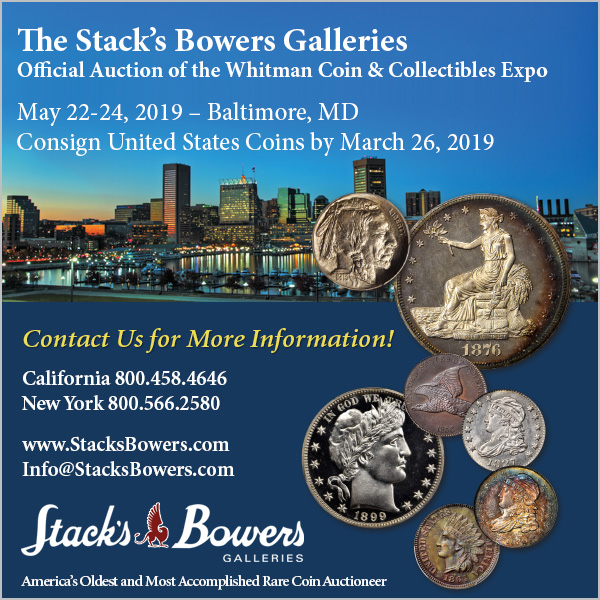
NUMISMAGRAM MEDAL SELECTIONS: MARCH 2019
Jeremy Bostwick sent along these four medals and plaques from his most recent upload of new material at Numismagram. In addition to the pieces below, this month's offerings are rounded out by some high grade orders and decorations, a few other highly artistic plaques, a choice Admiral Vernon medal, a gem architectural type honoring Canterbury Cathedral, attractively toned medals for the Ford Motor Company and the LZ-127 Zeppelin, and an engraved token for traveling Wesleyan Methodist preacher Samuel Bates. -Editor
Chile Independence Centennial Plaque
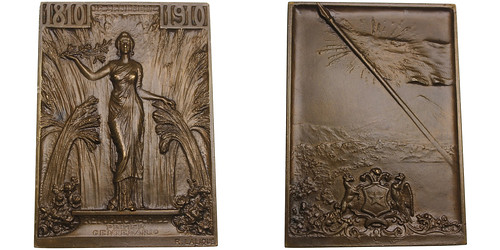
100596 | CHILE. Bronze Plaque. Issued 1910. Commemorating the centennial of Chilean Independence (42x60mm, 79.48 g, 12h). By R. Lalique. Personification of Chile, holding branch, standing facing within overgrown wheat fields; flowers below; in three lines in exergue, REPUBLICA DE CHILE / PRIMER / CENTENARIO / National flag over sunburst; mountainscape in background; coat-of-arms below. Edge: BRONZE and small triangular punch. Choice Mint State. Alluring warm brown surfaces, with just a hint of light rub on the highest points. A fairly rare and desirable piece; compare to an inferior example in Baldwin's 101 (28 September 2016), lot 3795, which realized a hammer of £300 [plus buyer's fee]). $435.
René Lalique was a famous French artist most known for his glass art during the Art Nouveau period, creating pieces such as perfume bottles, jewelry, chandeliers, and even automobile hood ornaments. A minor subset of his work was in the field of medallic art, of which there is only a small representation. The present piece commemorates the 100th anniversary of Chilean independence, and features Lalique's powerful yet elegant style for this important specimen of South American exonumia.
I wasn't aware of Lalique's medallic work. Great style. -Editor
To read the complete item description, see:
CHILE. Independence Centennial bronze Plaque. (https://www.numismagram.com/product-page/100596)
Panama-Pacific Exposition Award Medal
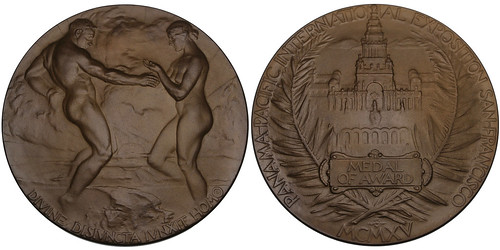
100578 | UNITED STATES. Panama-Pacific International Exposition bronze award Medal. Issued 1915. Presented at the expo for the bronze award (70mm, 131.00 g, 12h). By J. Flanagan. Nude male and female (personifications of the Atlantic and Pacific Oceans or eastern and western hemispheres) greeting one another as the sun rises over the Panama Canal in the background; DIVINE DISIVNCTA IVNXIT HOMO / PANAMA–PACIFIC INTERNATIONAL EXPOSITION SAN-FRANCISCO / MCMXV, façade of the Tower of Jewels within wreath of palm fronds; MEDAL OF AWARD in garnished cartouche below. Edge: Plain. Baxter 114; Marqusee 150. Gem Mint State. Sublime matte surfaces, with a charming light bronze hue and subtle tone near the peripheries. Very rare this attractive and problem free. $465.
Designed by the famous American sculptor John Flanagan (best known in U.S. numismatics as the designer of the Washington quarter), the Panama-Pacific medal was issued as an award for many products and exhibits on display at the expo. Just 2,000 of these were struck and issued in bronze by the U.S. mint, and are now often encountered with spotting, scuffs, and other blemishes. The elegant design features personifications of the two oceans meeting, with the Panama Canal being at their middle. The expo itself was styled as a celebration of the completion of the canal (its first use was just six months before the opening of the expo), but in a wider sense, the fair gave the world a chance to see the recovery of host city San Francisco following the devastation of the 1906 earthquake.
A beautiful and rare medal. -Editor
To read the complete item description, see:
100578 | UNITED STATES. Panama-Pacific Int'l. Exposition bronze award Medal. (https://www.numismagram.com/product-page/100578)
General Motors Bronze Medal

100590 | UNITED STATES & SWEDEN. General Motors bronze Medal. Dated 1928. Commemorating the Formation of General Motors Nordiska AB in Stockholm (69mm, 119.18 g, 12h). By H. Neujd. Struck by Sporrong & Co. A CAR FOR EVERY PURSE AND PURPOSE, antique car facing slightly left; upon the seas to left, viking longship sailing right; rising sun in background / GENERAL MOTORS NORDISKA A–B / SWEDEN, viking warrior and Native American standing facing one another; factory in perspective in background; STOCKHOLM in exergue. Edge: SPORRONG & Co. Svensk Numismatisk Tidskrift (Feb. 2002), p. 16. Choice Mint State. Brilliant yellow-bronze surfaces, with a charming underlying luster. $295.
Having become a successful automaker through the acquisition of other early brands and outfits, General Motors began to expand in the 1920's from its Michigan foothold to markets in Europe, opening factories in Copenhagen (1923), Antwerp (1924), and Stockholm (1928). This Stockholm facility was located in the Hammarbyhamnen harbor area in the southern part of the city, and a bird's eye perspective view of the plant is featured on the reverse of this medal. The detail of the engraving by the medallist, Herman Neujd, was so precise that one can just make out the name 'GENERAL MOTORS' in columnar fashion down the giant smokestack.
Great piece. -Editor
To read the complete item description, see:
100590 | UNITED STATES & SWEDEN. General Motors bronze Medal (https://www.numismagram.com/product-page/100590)
World Power Conference Bronze Plaque
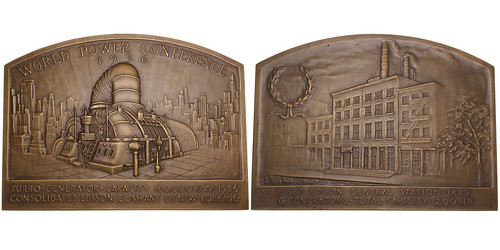
100591 | UNITED STATES. World Power Conference bronze Plaque. Issued 1936. Commemorating the 3rd World Power Conference in Washington, D.C., from 7-12 September (114x83mm, 12h). By R. Chambellan. WORLD POWER CONFERENCE / TURBO-GENERATOR – CAPACITY 160,000 K•W• 1936 CONSOLIDATED EDISON COMPANY OF NEW YORK INC, perspective view of the turbo generator; cityscape of New York in the background / Façade of the Edison Central Station; wreath to left, tree to right; in two lines in exergue, FIRST EDISON CENTRAL STATION – 1882 / 6 GENERATORS – TOTAL CAPACITY 1200 H•P•. Edge: Plain. Choice Mint State. Attractive yellow-bronze surfaces, with a charming matte nature. Very rare and interesting. $495.
The 3rd World Power Conference was held in Washington, D.C., from 7-12 September 1936, and concurrent with the 2nd Congress on Large Dams. Delegates from numerous nations were on hand to hear presentations on the state of energy in the world. Of note in relation to this plaque, Floyd L. Carlisle, chairman of the board of the Consolidated Edison Company of New York (ConEd), spoke on 10 September representing the electrical manufacturing group. The next day, President Franklin Roosevelt spoke and, during his speech, pressed a button to activate the flow of water–and subsequently, the generation of electricity–through Boulder (now Hoover) Dam.
Unusual topic, but a great piece for a collection on business and industry. -Editor
To read the complete item description, see:
100591 | UNITED STATES. World Power Conference bronze Plaque. (https://www.numismagram.com/product-page/100591)

LANGE OFFERS COIN FOLDER LIST #104
Researcher David Lange published the standard references for collecting U.S. coin boards and folders. He also publishes periodic price lists selling duplicates from his reference collection. Here are some selections from his latest list #104. for more information, contact Dave at DavidWLange@outlook.com or visit his web site (linked below). -Editor
"With the supply of desirable coin boards coming into the market being very thin recently it's once again time to look elsewhere for collectible coin holders. I've prepared another list of early (1939-50) coin folders that are very scarce, yet still quite affordable.
"This includes several rare, first edition (1941-42) folders by Whitman, as well as nice examples of Dansco and Oberwise folders from the 1940s. As a final treat, I'm offering a small hoard of Shore Line folders from that company's failed and exceedingly rare first edition. While these date from 1963, they are multiples in rarity of anything else on the list and are only seldom offered for sale."
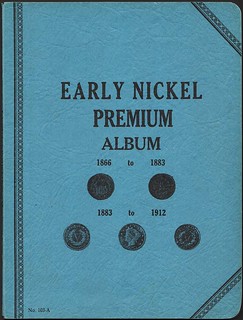
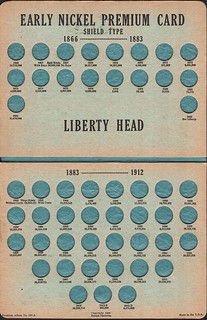
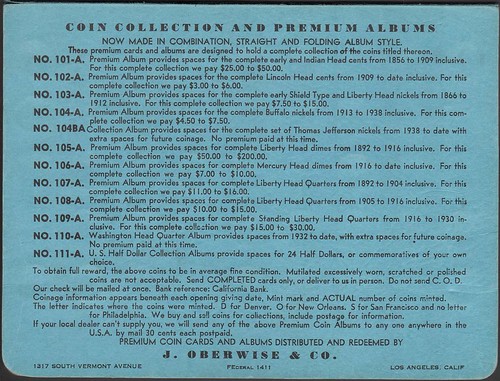
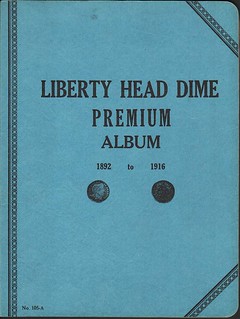
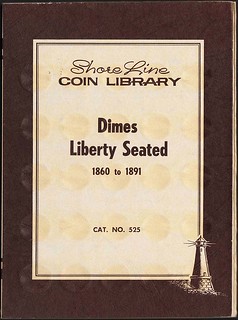
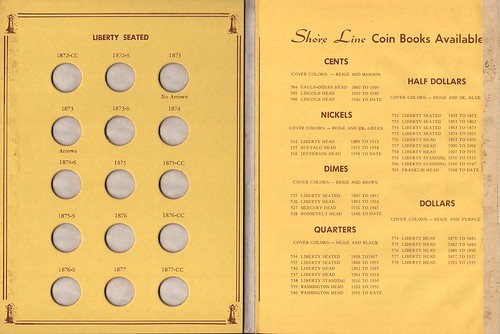

To visit Dave Lange's web site, see:
http://www.coincollectingboards.com/
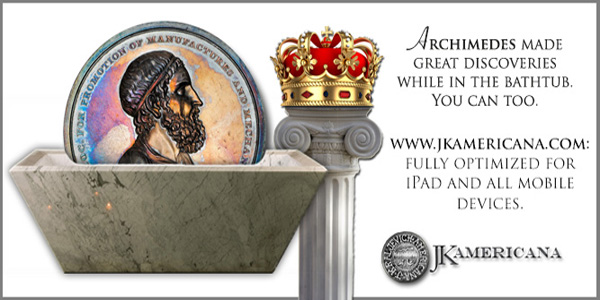
WAYNE'S NUMISMATIC DIARY: MARCH 10, 2019
Last Friday (March 1, 2019) I left work early and headed north toward Baltimore for the Whitman Baltimore Coin Expo. I arrived on the bourse floor about 3pm and found len Augsburger at the Seated Fest II table. We had plans to meet for dinner later. I had invited David Sundman of Littleton Coin and Len invited young numismatist Garrett Ziss and his parents. I had some time to kill and walked around the show visiting with friends old and new.
Charles Davis
First I visited numismatic literature dealer Charlie Davis. Already there was NBS Past President Michael J. Sullivan. We talked about his great consignment of paper money numismatic literature in that evening's Stack's Bowers sale. See the article in last week's issue for more information.
Later Charlie showed me a photo from the 1981 New Orleans ANA convention which included Jim King and Ann King, Arthur Fitts, Dick Margolis, and Charlie Wallace. Thanks!
Craig Sholley
While hanging out at Charlie's table Craig Sholley and his wife Bonnie came by. Craig showed me an electrotype of the Jefferson Head cent made from the piece in the American Numismatic Society collection. Beautiful piece.

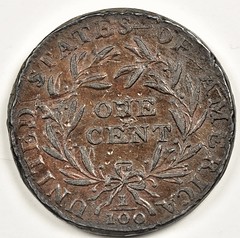
Craig also had with him the only known striking from the Newman-107 obverse Fugio die, a double-struck die trial over a 1798 DB cent.


Craig adds:
The S80 electro would be perhaps the nicest known if some idiot hadn't "spooned" the edge in a futile attempt to hide the seam.
The Newman 107 die trial had previously been misidentified as both Newman 105 and 106. I identified it a few weeks ago based on the positions of the two lower cinquefoils, which are unique to 107.
As chance would have it, another nice electrotype walked up in the hand of Alan Weinberg. It was a holed Washington skull & crossbones funeral medal.
Northeast Numismatics
Tom Caldwell and Chris Clements of Northeast Numismatics had some time to spare and we talked for a good while. They didn't have their newly acquired Don Lutes discovery specimen of the 1943 copper cent with them, but they will display it at at the upcoming Bay State show in Marlboro, Massachusetts.

Tom Caldwell and Chris Clements
I looked through their stock and asked about the "Ghost" Oak Tree Shilling. They explained that the variety is so named because of the shallow relief and thin, spindly nature of the tree. Great piece. Here's my photo of it in their case, followed by shots from their web site.

The Ghost Oak Tree Shilling
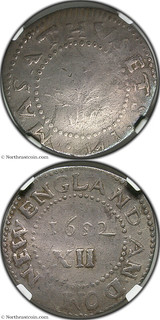
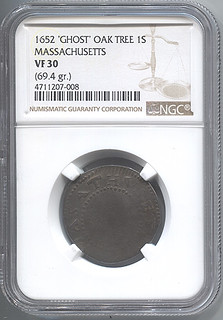
To view the coin on the Northeast web site, see:
https://www.northeastcoin.com/popupcontainer.jsp?include=vi&itemKey=zi01_471120708
Stephen Album Rare Coins

I also stopped by the table of Stephen Album Rare Coins and spoke to Mike Barry. I looked at a number of pieces but what most caught my eye was this Balloon School medal.

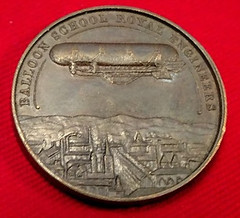
The Balloon School Medal
John Kraljevich
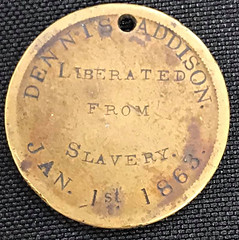 I probably spent more time at the table of John Kraljevich than anywhere else. We mostly discussed the Newman Numismatic Portal (and how to make finding information easier) and the emancipation dog tags illustrated in the last E-Sylum. These are fascinating pieces.
I probably spent more time at the table of John Kraljevich than anywhere else. We mostly discussed the Newman Numismatic Portal (and how to make finding information easier) and the emancipation dog tags illustrated in the last E-Sylum. These are fascinating pieces.
Jon Sullivan Error Coins
In recent issues I've illustrated some great error coins from the stock of dealer Jon Sullivan of John's Island, SC. I had never met him so I introduced myself at his table and we had a nice conversation.
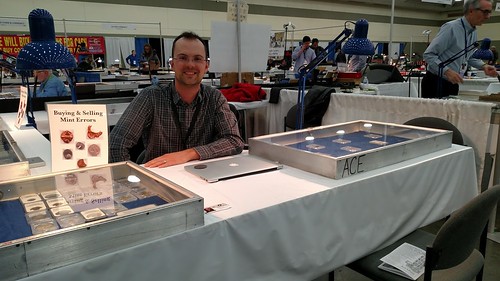
While discussing The E-Sylum Jon suggested a neat coin he recently acquired. It appears to be a U.S. Large cent struck over what could be a Canadian coin or token. He didn't have the piece with him but provided these images for publication. What do people think of this?
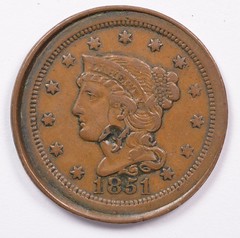

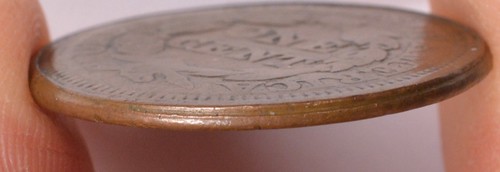
Jon adds:
The coin is an 1851 large cent and is a double-struck broadstrike, with a partial collar strike on the edge and a uniface 2nd strike on the reverse. It has a partial collar strike on the edge, and is slightly "cupped up" on one side of the coin (similar to a die cap.) The coin is also struck over a planchet that weighs 8.04 grams (a normal large cent weighs significantly more at 10.89 grams.) The planchet is copper.
There is a gouge in the obverse, and a few scratches (not an error.)
In a small amount of searching around, I discovered that a 1850's Canadian half-penny weighs about 7.9 grams (within tolerance for this coin) and also has a diameter of 27.6mm (which is 0.1% larger than a large cent (which is 27.5mm), but that also might account for the coin's partial collar…since it might've had a little trouble falling all the way into the large cent collar.)
The 1870-S Half Dime
At the Seated Fest II tables I asked to look at the 1870-S Half Dime. As it happened, the owner of the piece was there and he got it out of the case for me. I was curious to get an in-person look at the mintmark, which looked like a blob in the publicity images I'd seen.

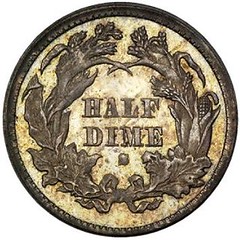
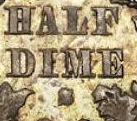 Yep. It's a blob. The owner agreed.
Yep. It's a blob. The owner agreed.
Dinner With Garrett Ziss
I later mentioned the piece to Garrett Ziss. He agreed as well, and may have invented a new word - "Yes, it's really blobular."
Around 6 I met up with my dinner party - Len, David, Garrett and his parents. Len had made a reservation at Sullivan's. We walked over in the rain but were quickly seated at a nice table. Dave ordered some wine. The meals were excellent and exceeded only by the fine conversation.
Topics included German beer steins, the Wilmington Coin Club, Jules and Iona Reiver, the Bust Nut Half Club, travel, Dave's Massachusetts silver collection, the ANA Summer Seminar, 1794 dollars (real and fake), the Invasion of Louisville, John Ford, the Nova Constellatio pattern set, the American Journal of Numismatics and much more. It was a very enjoyable evening of numismatic fellowship.
Dave walked with me back to my car (it was still raining!) and I gave him a ride over to his hotel, the Marriott. I had an hour's drive to get home but I didn't mind at all. What a great night.
NEXT UP: On Tuesday I have the regular dinner meeting of Nummis Nova, my Northern Virginia numismatic social group. If any readers are in town and would like to join us, let me know.
And later this month I'll be in Pittsburgh for the ANA's National Money Show. I'm attending the Welcome Banquet Wednesday night. If you'll be there and would like to share my table, let me know. It should be a fun night in a great venue.
To read the earlier E-Sylum articles, see:
SEATED FEST II BALTIMORE 2019 (https://www.coinbooks.org/v22/esylum_v22n08a16.html)
RESULTS FROM THE STACKS-BOWERS SULLIVAN SALE (https://www.coinbooks.org/v22/esylum_v22n09a03.html)
ANOTHER EMANCIPATION PROCLAMATION DOG TAG (https://www.coinbooks.org/v22/esylum_v22n08a11.html)
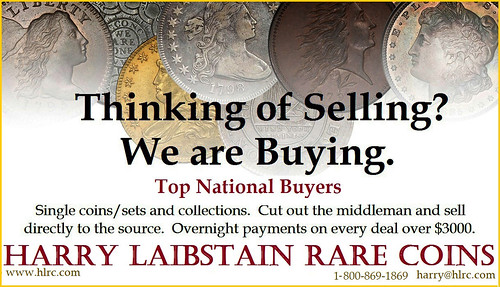
INDIAN ARCHAEOLOGISTS WARN ABOUT FAKE COINS
Arthur Shippee forwarded this article found via The Explorator newsletter. Thanks. -Editor
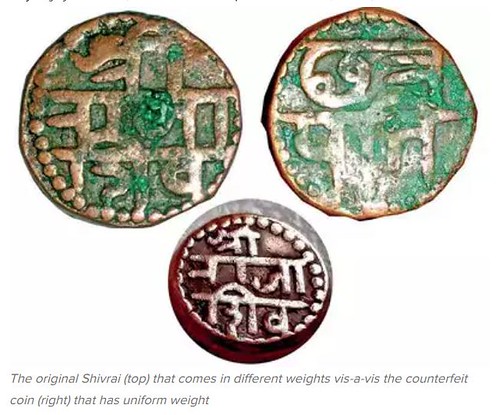 The state archaeology department has issued an advisory alerting coin collectors and history lovers that many counterfeit vintage coins are circulating in the market through online portals. It has also emphasised that most fraudulent activities are happening around the Shivrai, a copper coin minted during the reign of 17th century Maratha ruler Chhatrapati Shivaji and carried on by later Maratha rulers. It remained in circulation till the end of the 19th century, primarily in Bombay Presidency.
The state archaeology department has issued an advisory alerting coin collectors and history lovers that many counterfeit vintage coins are circulating in the market through online portals. It has also emphasised that most fraudulent activities are happening around the Shivrai, a copper coin minted during the reign of 17th century Maratha ruler Chhatrapati Shivaji and carried on by later Maratha rulers. It remained in circulation till the end of the 19th century, primarily in Bombay Presidency.
It has revealed that many rackets are active in Gujarat and West Bengal where fake coin die are being used to forge counterfeit Shivrai coins and are later being sold at cheap rates. The department has further appealed to the public to get coins checked by experts to avoid cheating. At present in the market such coins are available from Rs 600 to Rs 1,000, while the real coins cost between Rs 2,000 and Rs 3,000.
Talking to Pune Mirror, Vilas Wahane, assistant director of the state archaeology department, said, "Because fake coins are being circulated, people must cross check the genuineness of coins through numismatists as only they are aware of the standard weight and metal quantity."
To read the complete article, see:
State archaeologists warn about fake coins (https://punemirror.indiatimes.com/pune/civic/state-archaeologists-warn-about-fake-coins/articleshow/68261262.cms)

ALBANY CHURCH PENNY WITHOUT D VARIETY
A great colonial rarity is featured in a March 8, 2019 Stack's Bowers blog article. I was unfamiliar with this variety. -Editor
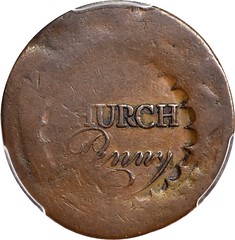
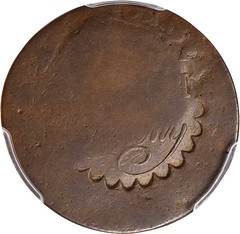
Fascinating Albany Church Penny Rarity
Without D Variety
Struck on Both Sides
Undated (1790) Albany Church Penny. W-8495. Rarity-7. Without D--Overstruck on an English George II Halfpenny--VF-30 (PCGS). This is a truly notable example of a legendary rarity among early American types. Unlike most Albany Church pennies that we have handled over the years -- and there have not been all that many -- this piece is struck on both sides. The side that PCGS has elected to mount up in the holder displays nearly 50% of the decorative cartouche. The word CHURCH is complete, although the letter C is extremely faint and the adjacent H is also weak, while the word PENNY is also complete despite softness at the base of the letter P.
On the other side we note, once again, nearly 50% of the decorative cartouche, but for the central words CHURCH is absent entirely and only the letters NY in PENNY are discernible. Traces of the undertype are faint, yet discernible with patience, the "obverse" (as mounted in the PCGS holder) displaying outlines to King George's portrait at the left and right borders as well as traces of the Roman numeral II at 4 o'clock. On the other side of the coin remnants of the exergual line and the final letter A in BRITANNIA are discernible along the border from 11 to 1 o'clock. Both sides are predominantly smooth in appearance with no marks or other post-striking blemishes of note. Warmly and evenly toned, as well, handsome medium brown patina further enhances this coin's already strong visual appeal.
The Albany Church pennies are attributed to the First Presbyterian Church of Albany, New York and were produced as a result of a resolution passed by the church elders on January 4, 1790. These pieces were intended to provide parishioners with coppers to place in the Sunday offering plates, this at a time when small change was extremely scarce in the area following the coppers panic of 1789. The resolution authorizing these coins is quoted in Q. David Bowers' 2009 Whitman Encyclopedia of Colonial and Early American Coins:
"Resolved: That one thousand coppers be stamped Church Penny, and placed with the treasurer to exchange with members of the congregation, at the rate of twelve for one shilling, in order to add respect to the weekly collections."
Two varieties were produced, one without a letter D added to the field above the word CHURCH, as here, and the other with a D added. This letter is thought to be an abbreviation for penny, or denarium, as it was known in the English monetary system. Both types are exceedingly rare with an extant population of fewer than a dozen coins each. This is one of the nicest examples of the Without D variety that we have ever handled, a fleeting opportunity for the astute collector of early American coinage.
"The exergual line" is a great phrase I don't recall seeing before. Excellent coin - a very nice example. -Editor
To read the complete article, see:
Undated (1790) Albany Church Penny. W-8495. Rarity-7. Without D--Overstruck on an English George II Halfpenny--VF-30 (PCGS). (https://www.stacksbowers.com/pages/lotinfo.aspx?LotId=1286109)

BRITISH INDIA HALF RUPEE BUST VARIETY
Leitton Rezaul of Bangladesh is a collector and researcher on British Indian Coinage. He submitted this article on a new die variety he's discovered. Thank you. -Editor
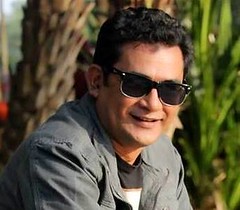 The study of the British Indian (BI) Coinage is an ongoing process; it is a vast area for researchers to research and present new discoveries. In Indian sub-continent, this is a popular subject for coin collectors; when new varieties coming up to collectors on a regular basis that makes this subject more interesting and thrilling. From gold Mohur to 1/12 Anna many denominations were introduced in the British Indian Period from 1835 to 1947 with various metal; perhaps not all the denominations were deeply researched.
The study of the British Indian (BI) Coinage is an ongoing process; it is a vast area for researchers to research and present new discoveries. In Indian sub-continent, this is a popular subject for coin collectors; when new varieties coming up to collectors on a regular basis that makes this subject more interesting and thrilling. From gold Mohur to 1/12 Anna many denominations were introduced in the British Indian Period from 1835 to 1947 with various metal; perhaps not all the denominations were deeply researched.
Let's take the example of one rupee coins, it can be noted that in regards to one rupee denomination many authors, experts, researchers and even senior collectors wrote their books, catalogues and articles on this one rupee coins and still they are doing their work on that and discovering new varieties, but comparatively this is rarely seen in case of other denominations. Many things are yet to discover in British Indian Coinage. Two new varieties of ½ rupee obverse of Bombay mint in Victoria Empress Period have been discovered which is described below with all the varieties introduced by Bombay mint in Victoria Empress Period.
There are four types of Obverse bust that considered in ½ rupee coins in Victoria Queen's period, like: bust A, B1, B2 and C. Bust B1 and B2 used by Bombay mint. Bust A and C were used in Victoria Queen's period for Calcutta mint and they both had many differences in their jabot panel and bodice embroidery floral design. Bust A has a small raised V like design and in some specimen reverse tick like design as privy mark at the center point of the baseline of the bust, which used in both the Queen and Empress Period from 1862 to 1899 for Calcutta mint but bust C was not used after Queen's Period.
In 1877, the very 1st year of empress period Bombay mint introduced a NEW BUST, which is similar to the old bust A. The new bust has a raised base line at the bottom of the bodice and some new embroidery floral designs, those embroidery floral designs are small but much prominent to identify the mint and do not match with old bust A which used by Calcutta mint from 1862 to 1899 (Queen and Empress both the period). The NEW BUST two images are shown below:
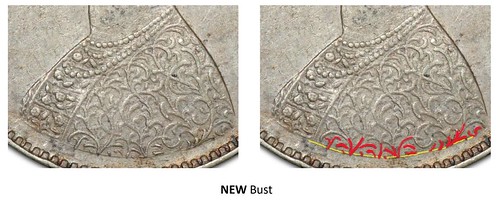
From the above images it can be noticed that - yellow line indicates the raised bottom line and red marking areas are indicating the new floral embroidery designs which is not matching with old A bust. Except those new designs, all embroidery floral designs are same with old bust A but the bodice embroidery design is little thicker than the old bust A. Let us consider to describe in detail with the split images below:
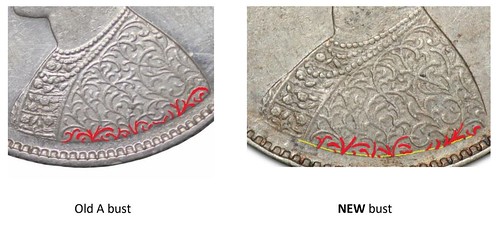
For better understanding the differences of those busts are explained in details by splitting it into two parts as shown below:
Part - 1

Left side image is from old A bust and Right side is from NEW BUST, the yellow line of NEW BUST indicates the raised line which absent in the old A bust. Both of these images have 7 black circles marked area and they show the embroidery floral design which reflects many differences between the two busts.
Part–2
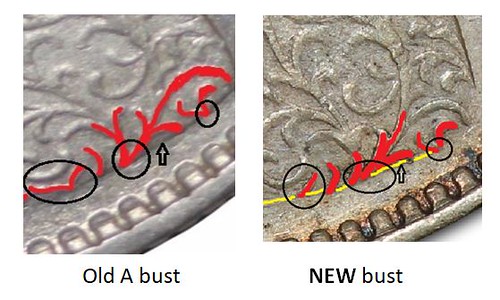
Left side image is from old A bust and right side is from NEW BUST both those images have three black circles which shows the different embroidery designs of both the busts and there is an arrow mark in both the images indicating the different gaps between the flower petal and base line of bodice.
By considering all the above discussions and comparisons it can be said that it is a NEW BUST, and thus this bust deserves a new name. Since this bust is similar with old bust A, so it can be named as bust A1. Bombay mint introduced this A1 bust in 1877 and this bust always came with Reverse II. Surprisingly Bombay mint did not use this bust in later date (except any mule). No record was found for the A1 bust in later date of Victoria Empress Period and Bombay mint also used old B2 bust from 1877 to 1884 in ½ rupee of Victoria Empress Series which also came with Reverse II.
In their next striking year (1881) of Victoria Empress Period for ½ Rupee coins, Bombay mint introduced another NEW BUST, and this bust is also similar with old bust A and new bust A1. This new bust also has a raised base line at the bottom part of the bodice like bust A1 but in some specimen bottom part of the bodice look like cut out. It has some prominent embroidery floral design at the bottom part of the bodice which does not match with old bust A or new A1, except those changes all embroidery designs are same. Below images are the new busts which introduced by Bombay mint in 1881:
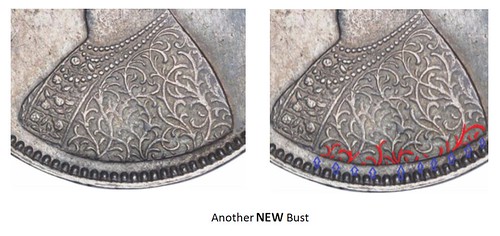
This is the new bust introduced by Bombay mint in 1881; those blue arrows show a raised base line at the bottom part of the bodice and new embroidery floral designs are shown by red color. The comparison of this NEW BUST with bust A1 is shown:
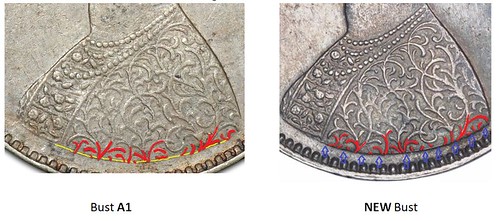
From the images above many differences on the floral embroidery design can be seen. The only similarity is the raised base line at the bottom part of the bodice but some floral designs have crossed the raised base line in bust A1 but in the NEW BUST no floral design has crossed the raised base line. For better understanding of the bust details, splitting the images of red marked floral embroidery designs area are done into two parts, as shown below:
Part - 1

Left side image is from bust A1 and right side image is from NEW BUST, each image has seven black circles and those circles indicate the embroidery floral design differences. It can be easily explained those differences particularly through each circle-marked area but here those circle marked areas are explain it all. 2nd part shown below:
Part – 2

Left side image is from bust A1 and the right side image is from the NEW BUST. Each image has three circle-marked areas to clearly indicate the design differences of the floral embroidery, and the only similarity between them is the arrow marked area; both have the same gaps in between floral design and base line of bodice.
Based on all these discussions, evidence and comparison with other busts now it can be considered as a NEW BUST, and this bust is similar with old bust A and new bust A1. So it deserves the name as bust A2. Bombay mint introduced this A2 bust in their 2nd ½ rupee striking year of Victoria Empress Period 1881 and from there on, most of the year they used this bust and this bust came with all the Reverse I, II and II (i), but there are few specific years where this bust has not been recorded yet, for example 1899.
In 1882 (3rd ½ rupee striking year of Empress Period for Bombay mint, 1st at 1877, 2nd at 1881), they introduced another NEW BUST which is pretty simple. Pridmore mentioned in his book about this variety as the only A bust variety of Bombay mint in Empress Period (page 126). Bombay mint used the old A bust design which used by Calcutta mint in both Queen and Empress Period from 1862 to 1899. In the old A bust there is a small raised V like design and in some specimen reverse tick like design as privy mark at the center point of the baseline of the bodice. However, in that NEW BUST there is no small privy mark raised V or reverse tick in the center point of the base line of the bodice but only the left stroke of raised V or reverse tick as privy mark.
Pridmore also mentioned about this privy mark (page 126) which is confusing. This bust actually came with both the Reverse I and II(i) with no changing of the privy mark in bodice, Pridmore also mentioned about this bust with modern proof restrike in 1877 (page 127). The most interesting thing is that, this variety was known as the only Bombay minted A bust variety of ½ rupee coins in Victoria Empress Period before this article. For better understanding of the bust details, splitting the images of red marked floral embroidery designs area are done into two parts, as shown below:
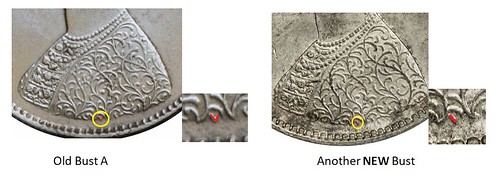
In old bust A there is a raised V or reverse tick like privy mark in the center point of the base line of bodice (above left image) and in the NEW BUST there is only the left stroke in the same point of bodice (above right image). Except that little change, all embroidery designs are same as old A bust. That difference is a minor one but much noticeable to identify the mint, so it is easily consider as a new variety. Considering Bombay mint issuance of varieties over the subsequent years, this variety may deserve a new name as bust A3.
Based on all findings, information, comparisons and analysis, it is evident that in total Bombay mint used four different busts for their ½ rupee Obverse in Victoria Empress Period: Bust B2 from 1862 to 1884 (both Queen and Empress Period), Bust A1 only used in 1877 (no record found for further years), Bust A2 from 1881 to 1898 (no record found yet in 1899) and Bust A3 from 1882 to 1899. Interesting enough, there are few dates where A2 and A3 were very difficult to get, such as, A3 is available in 1897 but not too easy to get in 1898, there are few mules exist in ½ rupee of Victoria Empress Series as well. Below images, showing all the busts used by Bombay mint in Victoria Empress Period:
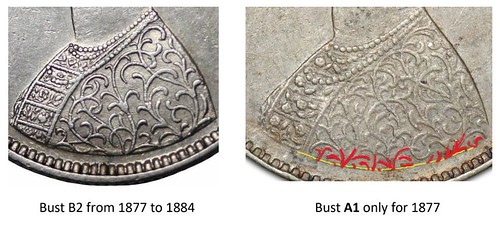
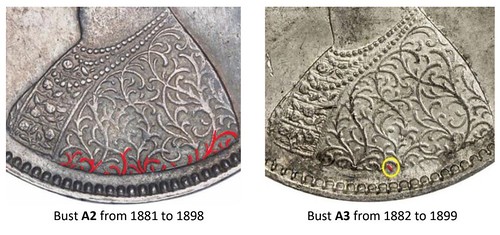
This article is based on circulated coins only and it is very important for serious collectors who like to collect rare, mule and unlisted variety of ½ Rupee coins in Victoria Empress Series.
REFERENCES:
THE COINS OF THE BRITISH COMMONWEALTH OF NATIONS, Part - 4 India. Volume 2 : Uniform Coinage East India company 1835-58 and Imperial Period 1858 - 1947. Author - F. Pridmore
Standard Catalogue of Coins of British India 1835 to 1947 Currency Issues Author - Gev Kias and Dilip Rajgor.
The Uniform Coinage of India 1835 to 1947 A Catalogue AND Pricelist Author - Paul Stevens & Randy Weir SPINK

CANADIAN FIVE CENT TERMS: FIPPENCE, FIPPENNY
Joseph Alan Barnosky of Camden, Michigan is a first year NBS member. Welcome aboard! He submitted the following notes on the Canadian five cent coin. Thanks. -Editor
I have read numerous references here and in other publications to information just not found in regular numismatic sources, but shedding valuable light on numismatic topics. I have recently stumbled onto something I suspect would be of great utility at a point of numismatic development, and was eager to share the reference.
Surely the erudite scholars of the NBS are well beyond, but might still have some recollection of passing through a stage, "stuck" somehow, waiting to be graced with some vocabulary wonder reminiscent of The Simpson's episode with the quote beginning "It embiggens a man..."
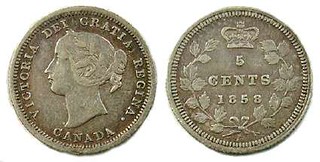 I have, this week, discovered such vocabulary. What do you suppose me to have been missing? What makes my family belly aches so Canadian? What did whose grandmother not tell what grandchild? A full set of 5 cent Canadian good enough... No. Newfoundland, too. Fishscales? Got it.
I have, this week, discovered such vocabulary. What do you suppose me to have been missing? What makes my family belly aches so Canadian? What did whose grandmother not tell what grandchild? A full set of 5 cent Canadian good enough... No. Newfoundland, too. Fishscales? Got it.
What were 5 cent coins called before they were made of nickel?
According to Appleton's New English-Spanish, Spanish-English Dictionary, 1941: fippence or fippenny. No lie. Found in a supplement to the third edition on page 571.
I encounter enough of these problems to have grown accustomed to summarizing the regarded episode of The Simpson's as: A little hard to cross-reference Englishman!
Any other folk genius I need to know about five cents?

THE GREEK HALF-DRACHMAI BANKNOTE
I missed this PMG blog post when it was published February 19, 2019. Thanks to the March 5, 2019 issue of News & Notes from the Society of Paper Money Collectors (SPMC) for bringing it to my attention. Here's an excerpt - seethe complete article online for more. -Editor
Greek notes that were cut in half helped stave off government collapse during economic turmoil.
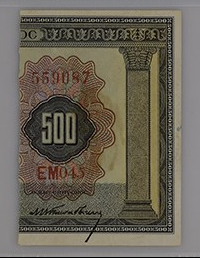 If you are relatively new to the world of numismatics you may think a banknote that is torn in half has little to no value. For the most part, it's true, but then there are those uncommon exceptions, like the Greek half drachma notes from the early 20th century.
If you are relatively new to the world of numismatics you may think a banknote that is torn in half has little to no value. For the most part, it's true, but then there are those uncommon exceptions, like the Greek half drachma notes from the early 20th century.
For this month's article, we are going to explore why some of these notes were cut in half, and how they helped Greece's government avoid total collapse despite economic troubles.
The economic depression led to a much-higher demand for smaller bills (the 10 drachmai being the smallest denomination available at the time).
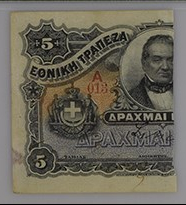 Even after a 5 drachmai note was issued in 1897, the people continued the practice of cutting notes, despite the fact that new notes issued had printed on them the clause "???G???????? ?? ????O???? ??S ??? ????S ????" (It is prohibited by law to cut in two pieces). The Greek government and National Bank must have either realized that the note cutting worked, or simply taken on the attitude of, "if you can't beat them, join them," because they would end up using a similar trick less than two decades later.
Even after a 5 drachmai note was issued in 1897, the people continued the practice of cutting notes, despite the fact that new notes issued had printed on them the clause "???G???????? ?? ????O???? ??S ??? ????S ????" (It is prohibited by law to cut in two pieces). The Greek government and National Bank must have either realized that the note cutting worked, or simply taken on the attitude of, "if you can't beat them, join them," because they would end up using a similar trick less than two decades later.
The economic depression of the 1920s affected many nations around the globe, including Greece. In 1922, the Greek government issued a forced loan in order to finance their growing budget deficit. On April 1, 1922, the government decreed that half of all bank notes had to be surrendered and exchanged for 6.5% bonds. The notes (see figure 2) were then cut in half, with the portion bearing the Greek crown (see figure 3) standing in for the bonds while the other half was exchanged for a new issue of central bank notes at half the original value.
The forced loan raised 1.6 billion drachmai, or roughly the size of the deficit. The half-drachmai trick once again proved to be only a temporary fix and the economy continued to flounder.
To read the complete article, see:
The Greek Financial Crises: Getting by with the Half-Drachmai (https://www.pmgnotes.com/news/article/7195/The-Greek-Financial-Note-Crisis-of-Early-1900s/)
THE BOOK BAZARRE
CURRENCY IDENTIFIERS
In a February 28, 2019 Blind Coin Collector blog post, Tom Babinszki wrote about his collection of currency identifiers. -Editor
It was by accident that I ended up with a collection of currency identifiers. Let me explain. Recently I started to research accessible currencies for people with visual impairment. It didn't take long to figure out that it will not make much sense on a theoretical level, because reading about it is one thing, but if I wanted to really understand accessible currency, I had to get my hands on a few.
Thus, I started to get a few different currencies with dots and other marks. The next part of the research was alternative identification of currency, when a bill is not identifiable by touch only. There are several methods, I wrote about it when I described how blind people recognize currency. You will also find pictures of some of the identifiers there.
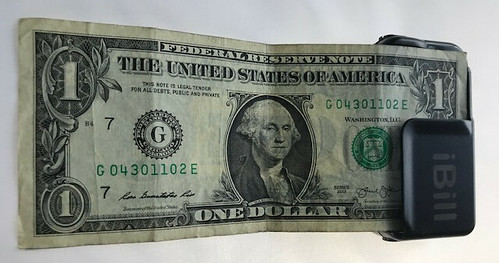
The topic just fascinated me, and before I knew, I had a pile of different tools from many countries which blind people use to recognize currency.
Then the next logical step was to download all kinds of apps and software which uses information technology to use the same, so now I also have a pile of apps to recognize currency. Now my research makes more sense, and in the meantime I have developed an interest for a collection that is relatively hard to categorize. Fortunately I don't have to, I just need to enjoy it.
If you have any money identifiers and you would be willing to part with it, please let me know.
To read the complete article, see:
My new collection: currency identifiers (https://blindcoincollector.com/2019/02/28/my-new-collection-currency-identifiers/)
To read Tom's article on how blind people dentify paper money, see:
How Blind People Identify Paper Money (https://blindcoincollector.com/2019/02/18/how-blind-people-identify-paper-money/)
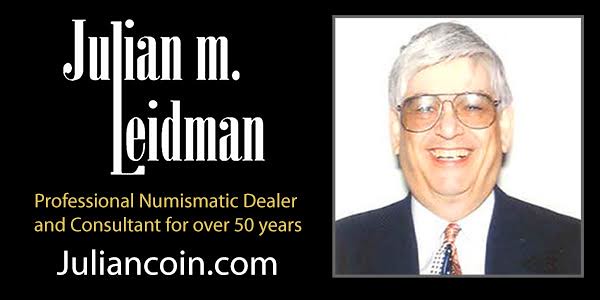
LIBERIAN BANKNOTE SCHEME REVEALED
From the "want-another-$100-million-with-that?" department: We previously discussed Alves Reis, "The Man Who Stole Portugal" with his audacious 1920s con scheme in which he fooled a banknote printer into believing he was an authorized government official. They delivered to him a batch of freshly printed unauthorized but otherwise 100% genuine banknotes. This story from Liberia describes a similar scheme involving the son of a Liberian official and a supersized order of freshly-printed banknotes. -Editor
Liberian police on Monday formally charged the 61-year-old son of the country's former president, Ellen Johnson Sirleaf, in connection with the unlawful overprinting of local currency worth millions of U.S. dollars. Separately, police also opened an investigation into the death of a central bank official.
According to the charge sheet shared with The Associated Press by police, Charles Sirleaf and others, including former Central Bank governor Milton Weeks, face a multitude of charges, including economic sabotage, the misuse of public money and criminal conspiracy.
Their arrests came after a government report and a separate U.S.-commissioned report pointed to the mishandling of billions of Liberian dollars in local banknotes.
According to the U.S.-backed report, Liberia's central bank unlawfully ordered three times the number of bank notes it had been authorized to print, money that it can't wholly account for.
Sirleaf was a deputy governor at the country's central bank during the period when the bank notes were unlawfully ordered. Sirleaf has denied any wrongdoing.
The U.S. Embassy in Monrovia commissioned the probe by the U.S.-based firm Kroll Associates following reports in August that about $100 million worth of Liberian bank notes had disappeared — an amount equal to nearly 5 percent of the West African country's GDP.
Kroll said its investigation found no evidence of a large shipment of cash going missing as had been reported by local media. Instead, the new bank notes are said to have arrived from a Swedish company but the central bank then failed to properly track what was done with them. The report said most of the bank notes are believed to have been put into circulation without authorities removing and destroying the old bills they were designed to replace.
To read the complete article, see:
Liberia police charge son of ex-leader in banknote scandal (https://www.apnews.com/e65184f62e944545aa3941d87945de28)
Dick Hanscom forwarded this BBC News article. -Editor
The son of Liberia's ex-President Ellen Johnson Sirleaf has been charged with economic sabotage in connection with the unlawful printing of local currency worth millions of dollars.
To read the complete article, see:
Liberia's 'missing millions': Charles Sirleaf charged (https://www.bbc.com/news/world-africa-47450217)
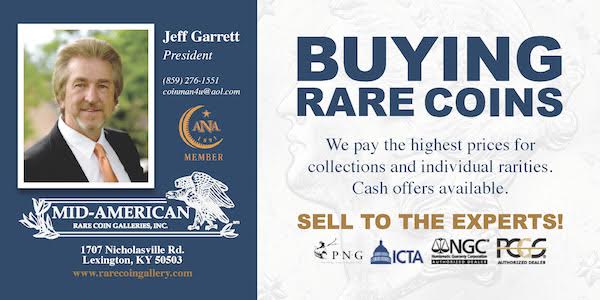
U.S. MINT PROOF BULLION COINS AS INVESTMENTS
While looking for other things I came across this November 26, 2017 Wall Street Journal article about the dubious utility of U.S. Mint proof bullion coins as investments. It still rings true today. -Editor
 The government currently is selling the gold-coin proofs at a 25% markup over per-ounce gold prices, a premium that can run as high as $360 per coin. The silver coins carry a more than 200% premium over market silver prices.
The government currently is selling the gold-coin proofs at a 25% markup over per-ounce gold prices, a premium that can run as high as $360 per coin. The silver coins carry a more than 200% premium over market silver prices.
That might be well worth it for coin collectors and hoarders—or for stashing in a post-apocalypse bunker along with the guns and freeze-dried macaroni. But some unhappy investors have deposited them into retirement accounts, where the shiny gold and silver coins have performed like lead sinkers.
Paul Rumage, a 64-year-old retired software engineer from Michigan, said he was looking for a haven from stocks for his individual retirement account in 2013. A private dealer persuaded him to buy 45 four-coin sets of American Eagle gold proofs, and 979 ounces of silver Eagle proofs, records show.
You can guess where this is heading. The "investment" turned out to be a dud. -Editor
The U.S. Mint does operate a bit like a coin dealer. Salespeople answer phones. An online store, with a pop-up chat window, adorns the website. Customers can sign up to have annual proof sets charged to their credit cards.
Mint profits on gold Eagle proofs hit nearly 18% last year. Net profits on the Silver Eagle proofs were even better, reaching about 41% last year.
The Mint transfers its profits to the Treasury's General Fund. "We are not in it to make money," said Kristie McNally, the Mint's chief financial officer.
Mint officials said they pitch proof coinage as collector's items, not investments. But Congress kept the door open to putting the coins into retirement account investments a few years after banning other collectible items in 1981.
The final paragraph summed up the situation for buyers well. -Editor
Nonetheless, Jeffrey Christian, a precious-metals investment adviser, said he steers his clients away: "It's sort of like buying a car and driving it off the parking lot. It will have an immediate depreciation."
To read the complete article (subscription required), see:
U.S. Mint's Gold and Silver Coins Turn to Lead for Some Retirement Investors (https://www.wsj.com/articles/u-s-mints-gold-and-silver-coins-turn-to-lead-for-some-retirement-investors-1511720285)
LOOSE CHANGE: MARCH 10, 2019
Here are some additional items I came across in the media this week that may be of interest. -Editor
Beatrix Potter 50p Coin Murderer Convicted
Here's a follow-up from The Sun about the man who murdered a fellow coin collector over a Beatrix Potter coin. -Editor
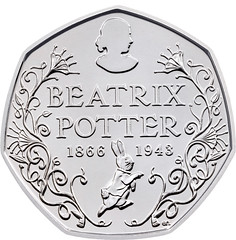 A COIN collector has been found guilty of murdering a fellow enthusiast for the rare Beatrix Potter 50p and trying to hide the crime.
A COIN collector has been found guilty of murdering a fellow enthusiast for the rare Beatrix Potter 50p and trying to hide the crime.
Danny Bostock, 33, attacked Gordon McGhee, 52, in his Essex home - stabbing him 17 times in a brutal onslaught.
He then turned on a gas cooker and left a dish cloth burning in a hallway in an attempt to blow up the building and destroy all evidence.
Bostock denied the killing, but was today found guilty of murdering Mr McGhee, and will be sentenced later this month.
To read the complete article, see:
COIN KILLER Coin collector found guilty of murdering fellow enthusiast for rare Beatrix Potter 50p then trying to blow up scene to hide crime (https://www.thesun.co.uk/news/8595747/coin-collector-murdered-fellow-enthusiast-beatrix-potter-50p/)
To read the earlier E-Sylum article, see:
LOOSE CHANGE: FEBRUARY 24, 2019 : Collector Murdered Over Beatrix Potter 50p Coin (https://www.coinbooks.org/v22/esylum_v22n08a46.html)
Queens Confused on Costa Rican notes
A Bank Note Reporter article by Kerry Rodgers examines some curious Costa Rican banknotes with images of British Queens... sort of. -Editor
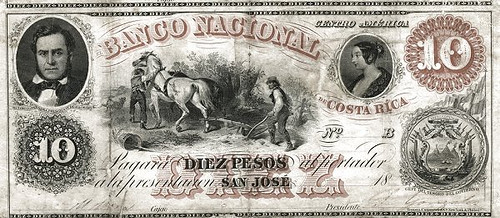
For reasons best known to the issuing banks, several early Costa Rican bank notes show vignettes of one and possibly two British Queens – although one was merely a Princess at time of issue.
To read the complete article, see:
Queens confused on Costa Rican notes (https://www.numismaticnews.net/article/queens-confused-on-costa-rican-notes)
On Daylight Saving Time
And for those of us in the U.S. where we lost an hour of sleep this weekend due to daylight saving time, here's an article advocating for a move to DST year-round. -Editor
In my research on daylight saving time, I have found that Americans don't like it when Congress messes with their clocks.
In an effort to avoid the biannual clock switch in spring and fall, some well-intended critics of DST have made the mistake of suggesting that the abolition of DST – and a return to permanent standard time – would benefit society. In other words, the U.S. would never "spring forward" or "fall back."
They are wrong. DST saves lives and energy and prevents crime. Not surprisingly, then, politicians in Washington, California and Florida are now proposing to move to DST year-round.
Congress should seize on this momentum to move the entire country to year-round DST.
To read the complete article, see:
5 ways life would be better if it were always daylight saving time (https://theconversation.com/5-ways-life-would-be-better-if-it-were-always-daylight-saving-time-111506)
FEATURED WEB SITE: NUMISMAG
This week's Featured Web Site is suggested by Tom Babinszki, who writes:I came across a European site called Numismag. It is relatively frequent numismatic news mostly from Europe, very similar to what www.coinupdate.com is in the US.

https://numismag.com/

